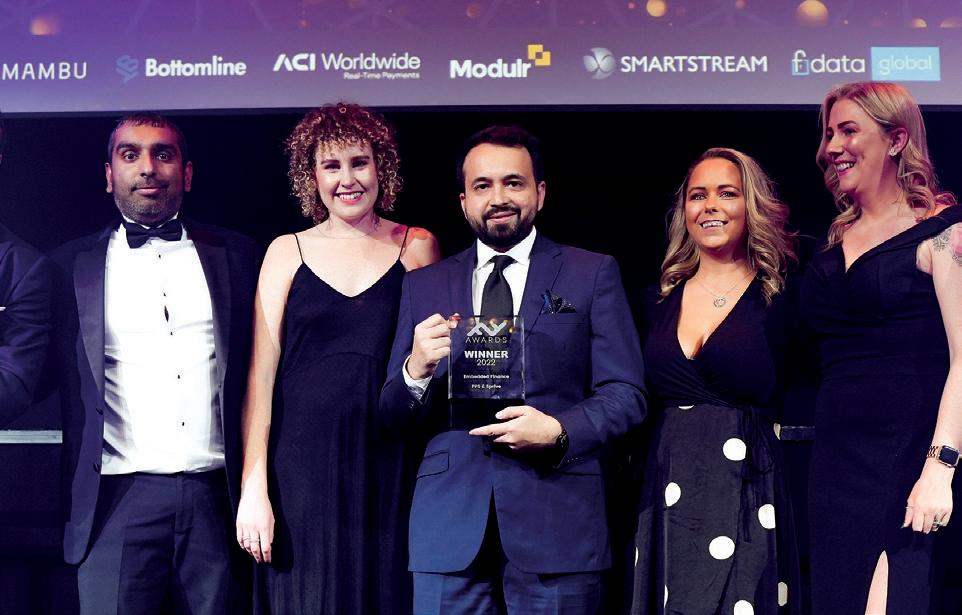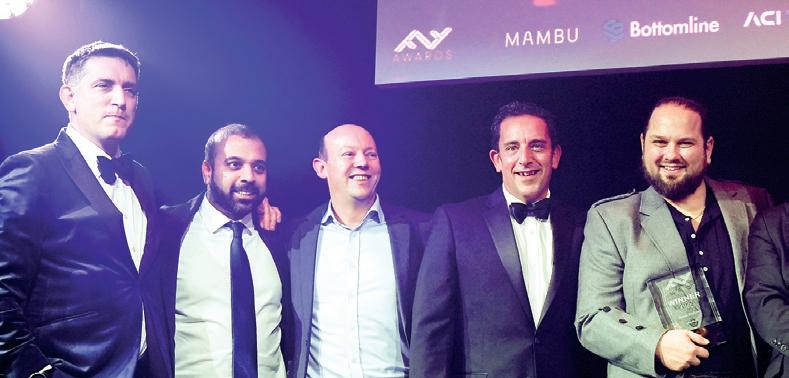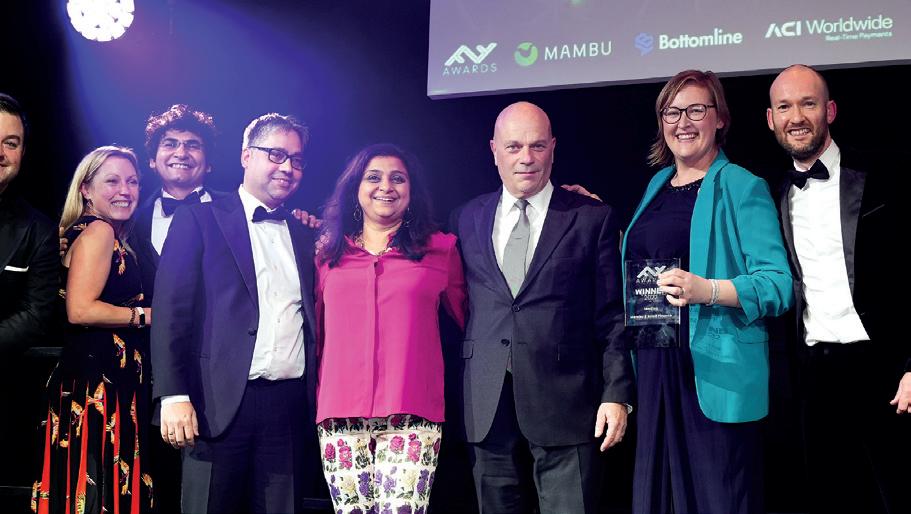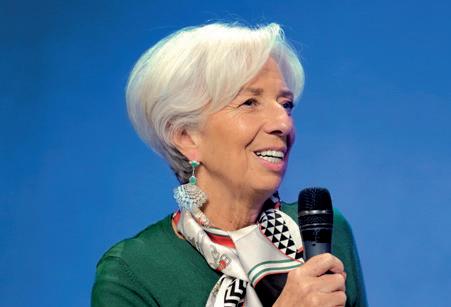









ISSUE#26 FINTECH GOES HOLLYWOOD! THE FF WALK OF FAME 2022: LIGHTS, CAMERA, ACTION... BUT WHO WERE THE WINNERS? Intix ● Adjoin Homes ● Revolut ● SmartStream ● Feedzai ● SAP Fioneer Mobiquity ● Adyen ● FINCAD ● UL Solutions ● Kani Payments ● Trulioo ● Oxbury Bank INSIGHTS FROM










A COLLECTION OF EXCLUSIVE EVENTS & DIGITAL CONTENT THROUGHOUT THE YEAR parisfintechforum.com PARIS ∞ NETWORKING 10 0 SPEAKERS 50 0 PAR TICIPANTS 4 0 COUNTRIES PARIS ∞ NETWORKING 10 0 SPEAKERS 50 0 PAR TICIPANTS 4 0 COUNTRIES PARIS ∞ NETWORKING 10 0 SPEAKERS 50 0 PAR TICIPANTS 4 0 COUNTRIES PARIS ∞ NETWORKING 10 0 SPEAKERS 50 0 PAR TICIPANTS 4 0 COUNTRIES PARIS ∞ NETWORKING 10 0 SPEAKERS 50 0 PAR TICIPANTS 4 0 COUNTRIES
FINTECH FOCUS

20 The Fintech Finance Awards
The best of the guests and the winners who wowed us in 2022 RESILIENCE &
SUSTAINABILITY
6 Going to X-tremes
Financial institutions have long been required to monitor transaction data. But now both regulators and stakeholders are demanding insight on a wider range of issues, the volume of information and analysis demands a new approach, says André Casterman from Intix

8 Mutual benefits
Financial institutions, by and large, face the same challenges: talent, time, cost and, increasingly, pressure not to contribute to environmental damage. Haytham Kaddoura, CEO of SmartStream, argues they’re four good reasons to let it share the load

10 The SAP is rising
Dirk Kruse, CEO of SAP Fioneer, on how this ambitious joint venture is focussed on helping financial services tackle one of the most pressing problems of our time… the thorny issue of ESG data management

13 Moving on Alex King explores how mobility as a service could be morphing into a broader embedded concept
NEOS & CHALLENGERS
16 Which way now for Generation Rent?
Adjoin Homes is among the newest of the proptechs trying to solve the dilemma facing thousands of tenants who'd like to buy their own home, but can’t. Founders Marios Tsatsos and Kostas Zachariadis know how it feels
THEFINTECHVIEW

ISSUE #26 2023
Five hundred guests; 18 worthy winners: three men in kilts; one 80s girl band… and a col-our-ful form-er MP. If you hummed that to the tune of Partridge In A Pear Tree, well done and apologies for planting the earworm.
We make no apologies, though, for celebrating the awesome creativity of the industry at our second pre-Christmas ‘Oscars’, the FF Wow Moment Awards, of which you’ll find full coverage, beginning on page 20 of this issue.
When Editorial Director Ali Paterson (pictured below) launched the Wows, they were very much intended to be an antidote to the sometimes yawningly dull ceremonies that he’d attended over the years – an excuse to layer on the movie glitz and for guests to be put in the hall of fame, courtesy of our talented filmmaking team.

No-one pays to submit their video entries (of which there were 350 this year) and no-one knows in advance if
they've won (which perhaps explains the lack of acceptance speeches!).
The Wows recognise creativity in building solutions to a huge diversity of challenges facing financial services and their users, not least in the overlapping areas of Trust & Security and Resilience & Sustainability – both of which we explore in detail in this issue.
We ended the year with news of the first co-ordinated APP fraud sting, resulting in more than 140 arrests (page 57), and Brussels agreeing a controversial world-first carbon border tax as it doubles down on climate change action. So, there’s both a promise of progress but clearly also of more complexities for fintech to address in 2023. We look forward to being ‘wowed’!
Our last issue’s spine tingler, “Perhaps we make too much of what is wrong and too little of what is right”, was a quote from HRH Queen Elizabeth II
Sue Scott, Editor
CONTENTS
Issue 26 | TheFintechMagazine 3
6 16
18 Growing smarter
Oxbury Bank is alone among UK agritechs in having a full banking licence. Co-founder Nick Evans told us how it’s ploughing its own furrow
WINNING STRATEGIES
26 Taking a different route
As competition hots up in cross-border payments and the correspondent banking network hits back, we ask three players from different sides of the tracks, how the explosion of new services will play out for customers
30 Scaling fintech

Revolut and Kani Payments are both UK-based fintechs with their sights set on expansion. Here, André Silva and Aaron Holmes discuss how the neobank and the PSP respectively are scaling up in an environment where trust and compliance can define your success
34 Lighting up the radar
Mobiquity offers advice on how to differentiate your banking app in a sea of sameness

TRADING
38
A new normal?
Technology and regulation have moved on since the last global recession, giving investors better tools to navigate what looks likely to be a year of extreme uncertainty – one in which none of the old rules about economic performance seem to apply. We asked two leading providers to the market – Christian Kahl PhD, President of FINCAD, the capital markets division of Zafin, and Gennadiy Friedman, MD of Enfusion – for their analysis
43 Changing the menu
Ian Manocha, CEO of Gresham Technologies plc, on why automating data management is fundamental to reducing risk and improving customer experience

TRUST & SECURITY
46 Embedded trust

Adyen has recently expanded into financial services on the back of a full banking licence, with a workforce that puts security at the heart of
every task, says CTO Alexander Matthey. Here, he discusses its approach alongside Mark Phillips, Senior Consultant at cybersecurity consultancy Dionach
51 How to build confidence in crypto

Michael Ramsbacker, Chief Product Officer at Trulioo, the global identity verification specialist, considers what exchanges can do now to restore faith in the industry
54 Change of tune
The US payments landscape is fundamentally changing, with ISO 20022 helping to bring harmony to a discordant environment.
Ravi Sharma from global leader in applied safety science UL Solutions gives his perspective on the impact
57 The big sting
Could the UK-led purge of the iSpoof site and subsequent arrests across multiple jurisdictions mark a turning point in the detection and enforcement of APP and other fraud? asks Alex King
4 CONTENTS THEFINTECHMAGAZINE 2023 ISSUE #26 4 18
51 30
All Rights reserved. No part of this publication may be reproduced, stored in a retrieval system or transmitted in any form or by any means, electronic, photocopying or otherwise, without prior permission of the publisher and copyright owner. While every effort has been made to ensure the accuracy of the information in this publication, the publisher accepts no responsibility for errors or omissions. The products and services advertised are those of individual authors and are not necessarily endorsed by or connected with the publisher. The opinions expressed in the articles within this publication are those of individual authors and not necessarily those of the publisher. EXECUTIVE EDITOR Ali Paterson GENERAL MANAGER Chloe Butler EDITOR Tracy Fletcher PRODUCTION Taylor Griffin HEAD OF CONTENT Douglas Mackenzie CONTENT TEAM Aniqah Majid HEAD OF MARKETING Ben McKenna CONTACT US ffnews.com DESIGN & PRODUCTION www.yorkshire creativemedia.co.uk ART DIRECTOR Chris Swales PHOTOGRAPHER Jordan “Dusty” Drew ONLINE EDITOR Lauren Towner ONLINE TEAM Lewis Johnson-Pitt FEATURE WRITERS Hannah Duncan David Firth ● Tim Goodfellow Martin Heminway Alex King ● Natalie Marchant Sean Martin ● Sue Scott Frank Tennyson Fintech Finance is published by ADVERTAINMENT MEDIA LTD. Pantiles Chambers 85 High Street Tunbridge Wells, TN1 1XP SALES TEAM Tom Dickinson Nicole Efthymiou VIDEO TEAM Lewis Averillo-Singh Alexander Craddock Max Burton IMAGES BY www.istock.com PRINTED BY LA Printers Ltd "PROUDLY NOT ABC AUDITED" TheFintechMagazine | Issue 26 ffnews.com

banking
payments
out
our low-code payments
visit
valantic FSA Passionate about payments. Digitize. Augment. Evolve.
valantic FSA is at the heart of the evolving
and
landscape –delivering powerful applications through X-Gen, our low-code/no-code platform. To find
more about
solution,
www.valantic.com/fsa
Financial institutions have long been required to monitor transaction data. But now both regulators and stakeholders are demanding insight on a wider range of issues, the volume of information and analysis demands a new approach, says André Casterman from Intix
Legislation typically lags innovation in the digital age and that assertion is clearly true in the case of environmental, social and governance (ESG) investing.
By 2020, global ‘sustainable’ funds that sat under the ESG umbrella totalled $35.3trillion, accounting for a third of the value of all professionally managed assets, according to investment research group Morningstar. While many of these complied with voluntary codes of reporting, such as that laid out by Global Reporting Initiative, it’s only recently that we’ve seen mandatory rules around ESG reporting being introduced.



For instance, in March 2021, the Sustainable Finance Disclosure Regulation (SFDR) went live in the EU to improve transparency in the market for sustainable investment products, to prevent greenwashing and to increase transparency around sustainability claims made by financial market participants.
The UK government’s first wave of Climate-related Financial Disclosure Regulations came into effect for publicly quoted companies, banks, insurers and large private companies in April 2022.
The UK is expected to adopt the International Sustainability Standards Board requirements for disclosures over climate and general ESG reporting by 2025, which must be linked to financial statements. And, in the US, the Securities and Exchange Commission released its consultation in March 2022 on a requirement for companies filing there, (including private foreign companies) to report direct and indirect emissions.
ESG is huge, complex and highly political – and it’s about to drop a vast regulatory burden on businesses around the world.
“ESG is going to be as important as the compliance trend that we witnessed following the financial crisis of 2008,” says André Casterman, chief marking officer of data-tracking software group Intix, which has a client portfolio consisting of Tier 1 banks across the world.

“It’s nascent – it hasn’t impacted all the bank systems yet – but, at the same time, climate change is a priority for the world. And it’s a priority for the regulators who are creating many new obligations on banks to handle ESG data.
“Whether this is related to an ESG scoring at a company level, or an ESG scoring at a transaction level, all of this data has to be stored, kept, archived, and be part of the decision-making within the banks.”
While some of the latest regulation is specifically concerned with understanding the size of the risk and protecting systemically important institutions from financial shocks caused by climate change, more broadly, the environmental component of ESG means a financial institution must consider how its actions – and, indeed, those of its suppliers and customers – impact the natural world, and come up with a strategy to mitigate it.
When it comes to meeting social responsibility obligations, a company needs to look at how its own, and potentially others’ management of relationships up and down the supply chain, affects individuals and communities. Governance, meanwhile, is something most companies have paid closer attention to following the Cadbury report in the 1990s; it requires them to demonstrate probity in leadership, auditing and internal controls.
The data needed to demonstrate regulatory compliance and satisfy internal reporting to stakeholders on the ‘E’ and ‘S’ in ESG requires institutions to gather information from disparate internal and external sources. That data is often hidden in a long-tail supply chain and often it will be qualitative by nature.
As Casterman points out, environmental reporting is comparatively new and has already sparked huge criticism by both supporters and detractors. There have been claims of ineffectiveness and greenwashing from environmental activists, while recently, during the US Congress mid-term elections, some Republicans went so far as to allege that ESG was part of a woke agenda by left-wingers.
In October it was reported that US investment giant BlackRock had lost more than $1billion in asset management business in Republican-run states where treasurers were opposing its green investment policies.
6 RESILIENCE & SUSTAINABILITY: REPORTING
TheFintechMagazine | Issue 26 ffnews.com
Environmental reporting is particularly fraught because there is as yet no universally agreed rating system against which to peg a company’s performance. Industry giants such as MSCI, Standard & Poor’s, Moody’s, Institutional Shareholder Services and Bloomberg provide ESG metrics but so do scores of others.
Whatever the protocol, the importance of these metrics is not lost on financial institutions: KPMG said recently that many in the UK were already transitioning their ESG data and reporting teams into finance ‘so that the same rigour can be applied to these metrics as to the reporting of financial information and disclosures‘.
The big data exchange
The sustainable investment revolution could transform businesses for the better, and demand for such products seemingly outstrips supply. A PwC study in October 2022 claimed nearly nine in 10 institutional investors believe asset managers should be more proactive in developing new ESG products, yet only 45 per cent of asset managers had new ESG fund launches in the pipeline. The UK investment market has already noted and is acting upon the unmet opportunity: London aims to become the world’s first net zero-aligned financial centre.
For Casterman, all this points to one truth: “Across multiple streams –securities, payments, trade, and so on – more and more data will have to be exchanged for organisations to be ESG compliant.”
Intix was acquired in March 2022 by Summa Equity, which invests in companies that are solving global challenges and creating positive ESG outcomes. Superior automated data gathering and analysis, such as that offered by Intix xTRAIL and xTRACE data tracking solutions and now xCOMPLY will go a long way to helping them achieve that.
xTrace and xTrail already allow firms to view all their transaction data in a unified graphic user interface as well as in machine-readable APIs. But xCOMPLY combines that transaction data with many
more data sets to deliver contextual insights that support compliance with a wider range of regulatory obligations and financial forensics. That includes ESG reporting.
“Whether it’s an ESG dataset, an anti-money laundering dataset or another type such as a master dataset, with xCOMPLY we can correlate them. Compliance officers will benefit, but it has other uses in the organisation, such as business or client support functions.”
Pointing to the growing complexity around data management, Casterman adds: “More and more internal systems within banks are being added, one next to the other. Different screening systems are run for payments, for securities, for trade, and all the requirements are different. The challenge for banks is to navigate through datasets that are scattered across these systems, and that’s what we enable – we provide a single window into the internal systems of the bank.
“We can add additional datasets as needs evolve without having to change our
ESG is going to be as important as the compliance trend that we witnessed following the financial crisis of 2008
platform. Being adaptable, configurable, to address additional needs from regulators, or as the market evolves, is a key aspect of our technology.”
Casterman believes the current fragmentation of payment systems will only add to the volume of data held by any one institution, which makes the case for automation even harder to resist.
“There are not only new entrants competing on cross-border payments but also we see the world dividing,” he says. “This year, we saw Swift disconnecting countries due to political decisions, which means there will be more systems used to process payments. So, banks have to connect to a number of channels, whether they like it or not. And they will have to
internalise as much data as possible because whereas, in the past, they could let some data be handled by those channels, such as analytics and reporting, they can no longer rely on this.
“At Intix, whatever channel the bank is using, we are always focussed on the payment, securities or trade transaction data, and we process it independent of the formatting of the instruction – MT or ISO 20022, or any other standard.
“We can provide the data for both automated and manual processes, but the key is for the bank to automate as much as possible to avoid compliance officers having to do all their linking manually because we know that leads to operational risks and errors.”
Intix has been advising clients on how to get their data in order for years, and now that regulators have a better understanding of the datasets available and their demands are becoming more specific, that advice is coming home to roost – not least because when it goes wrong for financial institutions, the fines and potential reputational damage can be severe.
“The way banks need to report transactions for regulators is undoubtedly becoming more complex,” says Casterman. “Regulators also want faster reporting –it’s no longer end-of-month. Everything has to be real-time.
“When it comes to conducting forensic investigation, every piece of data counts. You want to know everything around the parties involved, around the transaction, its origin – is it coming from a securities settlement, or a trade settlement or just a regular payment?”
Those are the questions that clients will, he hopes, come to rely on xCOMPLY to answer. But whether it’s information required under the ‘single EU rule book’ for anti-money laundering/countering terrorist financing – as is currently being discussed – or gathering the data to justify investment in a company that may or may not be greenwashing, Casterman says: “Our technology is ready for any change that the banks will have to go through.”
A changing landscape: Going forward, global warming will have greater impact on regulatory reporting

7
ffnews.com Issue 26 | TheFintechMagazine
Good for business, good for the planet: A single solution to a shared problem

Mutual benefits
Financial institutions, by and large, face the same challenges: talent, time, cost and, increasingly, pressure not to contribute to environmental damage. Haytham Kaddoura CEO of SmartStream, argues they’re four good reasons to let it share the load

ISO 20022 has become a preoccupation of the majority of players in the financial world, such is the transformative nature of the payment messaging standard imminently coming into play for many of them for the first time.
The protocol has already replaced existing domestic legacy payment standards in more than 70 countries and, says the UK’s NatWest bank, within five years we can expect to see around 80 per
cent of high-value payments by volume, and 90 per cent by value, using ISO 20022.
The benefits of adoption are obvious: a new global standard for payments messaging between financial institutions, enabling faster processing and improved reconciliation. Richer and better data, increased transparency, and automation of digitisation of payments, should help counter the malignancy of failed payments that currently costs the global economy $118.5billion in
fees, labour and lost business a year, according to Accuity data.
So, by any reckoning, ISO 20022 represents a positive move in the payments space, connecting the financial world with less friction and much more efficiency. However, with all these growing and increasingly complex volumes of data – 10 times more data per ISO 20022 message, according to EY – there is a downside: the processing capacity needed to handle not just the nominal increase in
8 RESILIENCE & SUSTAINABILITY: RECONCILIATIONS
TheFintechMagazine | Issue 26 ffnews.com
information, but the associated regulatory reporting, including ESG (environmental, social and governance) reporting, not to mention the environmental impact of all that additional processing.
“Regulation has been a wake-up call for banks,” says Haytham Kaddoura, CEO of global financial software and managed services provider SmartStream. “They would be fooling themselves if they weren’t expecting it, because everyone has seen the trend towards greater transparency.
“But the financial ecosystem is coming together – regulators, individuals, clients – to really help address some of the gaps that were in the financial sector, and still persist in certain areas. We have a long way to go to address all the challenges, but we continue to work very closely with some of the top institutions in the world, helping them to address these challenges, building their transparency, building the checkpoints in their business, to ensure that they are as compliant as possible.”
In order to handle the huge volumes of information now at play, financial institutions require technology – chiefly Cloud-native solutions. Among them, SmartStream AIR is capable of processing millions, or even billions, of lines of data per second.
This artificial intelligence (AI) reconciliation and exceptions management system learns from user behaviour, populating fields automatically, setting labels, running out of office hours.
It can provide suggestions to users, or fully automate the process, significantly improving straight-through processing (STP) rates. SmartStream AIR requires no training or configuration and is easy to onboard. Users simply upload raw data to the application, in any structured format. The application then matches the information using unsupervised AI.
AIR is just one of the cost-efficient solutions to come out of SmartStream’s innovation strategy to help data-rich, time-poor banks meet every-day challenges. In Kaddoura’s view, banks save significantly when partnering with a fintech like this, compared to developing or building upon a product themselves.
“I think there should be a neutral, fundamental look by institutions at what they need to do internally, from a
technology perspective,” he says. “The infrastructure costs for an institution today of doing everything itself is going to be phenomenal, and I don’t think, with the current economic challenges we are facing globally, it makes any business sense. I mean, it’s defeating the purpose. Banks and other institutions spend millions of dollars, only to realise, one or two years down the line, that they should have done it through somebody who actually does it for a living. There are many small and large companies like ourselves, that are profoundly proficient at what we do. We are the experts.”
The logic of using SmartStream AIR specifically is that it can be deployed within hours – not through the IT department, but by onboarding users directly to the Cloud-native platform, which picked up an award this year for its intuitive user interface (UI). The prestigious Red Dot Design Award was the first to be given for a financial reconciliation solution, beating off 20,000 entries submitted worldwide. Previous winners include the likes of Apple, IBM,
Banks
Samsung, ING and BMW.
In November, SmartStream also won a Fintech Finance ‘Wow Moment’ Award for Data Insights.
By combining human and artificial intelligence, organisations can better manage their workforce, says Kaddoura.
“People are increasingly work-from-home orientated, skills can leave an organisation with the churn of staff and there is a very real need to free up the people you do have, to carry out higher-value tasks. A more innovative approach is required.”
Such a Cloud-based service comes with efficiencies built in. No longer do you need a warehouse full of people in order to handle the huge volumes of
information being generated by data-rich payments that must be screened and reconciled; delivery is streamlined, more accurate, cheaper and, importantly, achieved with less impact on the environment, according to Kaddoura.
“Environmental efficiencies within the industry are not a matter of ‘if’ anymore. I think we’re all heading in that direction,” he says. “Multi-tenanted centres, moving to the Cloud, all helps in conserving and reducing the impact we leave on the environment.
“By unifying clients’ requirements, we are already moving towards greater, more efficient processing and some of the new processes and physical technology infrastructure changes will, I think, help us reduce our own footprint even further, and help our clients see the value, from an environmental impact perspective.”

AIR is testament to the work conducted by SmartStream’s Innovation Lab, which is based in Vienna and staffed by a cadre of research and data scientists, and technologists, who work alongside clients to drill down into their evolving priorities, then apply AI to solve them.
“With the advances in digital payments, the volume is just exploding globally. Institutions in unconventional markets are demanding the ability to handle 100 million transactions a day,” says Kaddoura.
“Our innovation team looks at enhancing our value proposition for clients, building that efficiency, the ability to handle masses of transactions. The focus going forward will be on reducing the cost of infrastructure for those institutions: the ability to upgrade, move quickly, lowering the cost of ownership for our clients; helping them with their regulatory compliance, as much as possible.”
The SmartStream approach, he says, is a pragmatic response to a long-standing problem; a way to reduce costs through mutualisation, albeit it through an external supplier.
“Many of the clients we see seem to have a similar problem, yet the basic notion of cooperating together to solve it appears not to be feasible,” says Kaddoura. “Therefore, it has to come through a third party like us. We look at our research offering in the reference data space and offer it to those that need it.”
That’s got to be good for business – and the environment.
9 ffnews.com Issue 26 | TheFintechMagazine
and institutions spend millions of dollars, only to realise, one or two years down the line, that they should have done it through somebody who actually does it for a living
The Fioneer spirit
The launch of SAP Fioneer in 2021 was a milestone in the long and distinguished history of SAP, the multinational, cross-industry technology leader that for 50 years has been at the forefront of developing enterprise application software.
Conflating the words ‘finance’ and ‘pioneer’, it’s a joint venture between SAP and Dediq, an entrepreneurial investor that focusses on digital businesses and information technology, and the aim is to accelerate the transformation across core banking, insurance and other members of the financial services (FS) industry.
The new company, which can be seen as both an extension to and a refinement of SAP’s existing business, was launched during a time of rapid change for FS. Due to the pandemic there has been an acceleration in the adoption of digital-first strategies and an increase in the demand for Cloud and platform-based businesses.
The banking and insurance industries have also recognised the need to quickly adapt and modernise in order to remain relevant in the digital economy and meet the expectations of consumers.
“We’ve built the SAP financial services business over more than 20 years,” says Dirk Kruse, SAP Fioneer’s CEO. “However, the marketplace has been unsettled by rapid changes and the amount of investment and capacity to go into products and portfolios. At SAP, we saw the need for change and wondered how we should organise our business, so that we can be the best innovation and transformation partner for our clients.”
In 2021 that thought process led to the creation of SAP Fioneer. “We took all the products, all the IP, all the experts, and much capital, and we invested it in a joint venture,” says Kruse. “SAP Fioneer is a carve-out, or ‘speedboat’, to drive innovation with energy and purpose. It’s a well-considered response to an industry challenge.”

While SAP’s technology and pedigree were unquestioned, the founders of SAP Fioneer knew that it would require a different type of enterprise – a leaner and more specialist organisation – to deliver the creative solutions being demanded by a rapidly changing financial industry. So while it carries the SAP name and is backed by all the resources of SAP’s global brand, SAP Fioneer is a standalone business. Or, to use Kruse’s phrase, separate but integrated. Underpinned by an ecosystem of handpicked, curated partners who help pull together collaborative solutions for financial services clients, it’s similar at first glance to pure-play FS providers Temenos’ and Finastra’s Cloud-based marketplaces.
But the big difference is that it draws on SAP’s experience in handholding clients in other sectors through digital transformation. Its USP comes from understanding how to transform enterprise business processes, not just the technology.
social and governance (ESG) principles and to demonstrate the highest standards in their operations. But, as global temperatures rise, so does the regulatory and stakeholder pressure on larger financial services companies to demonstrate corporate responsibility.

“ESG is a growing concern for our banking and insurance clients,” confirms Kruse, “and it’s a key element in our platform. From our conversations with clients and partners, we know there is a big demand for regulatory reporting from an ESG point of view. Data feeds, data providers and different data sources are all big discussion topics. In addition, most of our clients are concerned about data management – although they are collecting all the information, they don’t know how to manage it and build a single source of truth for ESG.”
So, SAP Fioneer has devised a way to deliver it through Sustainable Finance Data Hub: an integrated data pool that connects and harmonises external data sourced through partners in an ESG data marketplace with a bank’s internal ESG data. This ‘reliable, regulation-compliant single source of ESG truth within the bank’, will, ultimately, give rise to the SAP Fioneer Sustainable Finance Platform, which FIs can use for internal auditing and external reporting of climate-related metrics, satisfying both stakeholder and regulator demands for transparency.
System integration is a key part of the proposition – to bring everything together neatly in one place – and Kruse stresses that engagement and a close partnership with customers are crucial so that solutions always answer demand – at scale and at speed.
An excellent example of it rising to a topical challenge faced by FS providers, is how it’s helping them make the transition to ‘sustainable finance’.
Every company today is under scrutiny to embrace good environment,
With a global ratcheting up of climate-related reporting requirements –and countries shamed at the recent COP27 climate summit to make good on previous pledges to do even more – getting to grips with the ‘E’ in ESG is inescapable for
10 RESILIENCE & SUSTAINABILITY: DATA MANAGEMENT
TheFintechMagazine | Issue 26 ffnews.com
Going green: Missing or inconsistent data needs to be addressed
SAP Fioneer is a carve-out, or ‘speedboat’, to drive innovation with energy and purpose. It’s a well-considered response to an industry challenge
Dirk Kruse, CEO of SAP Fioneer, explains how this ambitious joint venture is focussed on helping financial services tackle one of the most pressing problems of our time… the thorny issue of ESG data management
financial institutions. But, speaking at Sibos 2022 in October, Ravi Menon, managing director of the Monetary Authority of Singapore, singled out the gathering of robust and trusted ESG data as one of the top two challenges for the financial services industry as it enters 2023.
“Sustainable finance is a powerful enabler for the net zero transition. High-quality, trusted ESG data is critical for comparable climate-related disclosures, management of environmental risks, and green and transition finance flows,” he said.
However, while quality data is foundational in the fight against greenwashing and in enabling relevant stakeholders to make effective ESG investment decisions, there was a significant gap between ESG data needs and the ESG data available, Menon added.
“We need good data on firms’ carbon footprint, historical carbon emission trends, and compliance with their respective transition targets. We also need data on the climate-related risks their physical assets are vulnerable to. But the ESG data acquisition process is often manual, tedious and costly. ESG data verification is at a nascent stage. This impacts the credibility of reporting. Fintech can be a key enabler in addressing these ESG data challenges.”
Kruse would like to think that SAP Fioneer’s Sustainable Finance Data Hub fits that description. It enables banks to handle their end-to-end ESG challenges centrally
across their business units. In addition, it includes a Sustainable Finance Workplace, which consolidates bank-integrated ESG applications, such as climate risk stress testing, ESG advisory, and emissions management and steering.
“The Sustainable Finance Data Hub is a platform solution we would like to offer to all our banking and insurance clients,” says Kruse. “To have this single source of ESG truth, and to be open to all the reporting providers, with SAP integration, is a versatile and powerful tool. We also want to be open, so that other reporting solutions can sit on top.”
What makes the hub unique, he says, is that it does more than simply connect to data feeds – it also informs decisions and opens conversations.
“It’s essential in financial services, especially the banking industry, to collect a diverse range of data, particularly in the credit and lending process,” he says. “In order to provide sustainable finance data on environmental, social and governance (EDG) issues, you will need to offer a user interface and integrate it into your loan origination process. This is because there will be no data provider that offers specific information on, for example, a wind park in the North Atlantic. “You have to capture that information yourself. So we’re building a user interface that allows you to incorporate your data and data feeds.”
That external data is sourced through SAP’s
ESG marketplace, and a clear audit trail is embedded in all banking processes. Notably, the solution also allows banks to collect client ESG data, which, according to a recent SAP Fioneer white paper
The Challenge Of Sustainable Sustainability: Accelerating The ESG Transformation In Banking is ‘a pressing use case at the moment for banks’ because ‘data availability from public and proprietary sources alone is insufficient in coverage and reliability in order to fulfil a bank’s ESG requirements’.

Client data collection consists of an easy-to-navigate frontend, pre-filled with existing internal and external ESG client data. This minimises manual input and, in particular, the time a bank might need for a corporate customer to provide ESG data.
Any bank currently employed in the task of compiling a carbon dossier on its clients in line with risk exposure audits or net zero alignment pledges will tell you that it’s an all-consuming task. But SAP Fioneer’s solution goes further by using ESG-trigger points to create an ESG advisory dialogue, which will help banks and their customers to accelerate ESG business transformation together.
A data collection and advisory workbench analyses client data and will alert relationship managers to the potential advisory needs of corporate clients, enabling bank sales teams to identify opportunities for ESG support.
SAP Fioneer’s ESG project is an early example of how it understands the pressures and competing demands that financial services companies face today and can focus the skills and energy of itself and its partners in a highly targeted way to support them.
In addition, the team is building a strong ecosystem of co-developers that will allow it to undertake many similar projects, says Kruse. “We’re building an inclusive, open, future-fit platform for our customers, prospects and partners,” he adds.
“The future is about ecosystems and platforms as a service, and SAP Fioneer is showing the way forward.”
11 ffnews.com Issue 26 | TheFintechMagazine





















































Evolve without fear of cyber attacks REAL SECURITY IN A VIRTUAL WORLD Mitigate risks and continually improve your organisation’s resilience with Dionach’s breadth of cyber security services. Dionach help you to understand your cyber security risks as a strategic cyber security partner. Schedule a free 30-minute consultation with us hello@dionach.com +44 1865 877830 dionach.com Penetration Testing Red Teaming PCI QSA Services ISO 27001 Consultancy Incident Response (CSIR) Security Auditing Security Consulting
Back in 2007, the revamped Eurostar line between London and Paris was unveiled. The £6 billion project, which included the revival of London’s St Pancreas terminus, would shave 40 minutes off the journey time between the European capitals.
This was money well spent, according to the organising stakeholders, who anticipated a 25 per cent increase in traveller numbers before the end of the decade. But when that boost failed to materialise, the project’s value for money was called into question. As behavioural economist Rory Sutherland has noted, for a tenth of the project’s budget, Eurostar could have hired all the world’s top male and female supermodels to patrol the train handing out free Château Pétrus, and people would have demanded the trains be slowed down.
Here, Sutherland hits on the key issue that has always plagued the mobility sector. People don’t choose their mode of transport based soley on each journey’s cost and duration, but on a litany of factors
which, in today’s world, include COVID security, relative emissions, and even how the journey makes them feel.
That’s a truth well understood by MaaS Global, a developer of mobility software that launched its app, Whim, in 2016. The Whim app connects users with every option in a city transportation network – including trains, trams, buses, taxis, bikes and e-scooters – via a pay-as-you-go model or a monthly subscription. The stated aim of the app is to ‘create a world where you don’t have to own a car to live a fulfilling life’, in recognition that easy, omniplatform access to the full spectrum of a city’s mobility options is enough to nudge users away from their private vehicles.
It’s little wonder that the concept of ‘mobility-as-a-service’ (MaaS) was forged in Finland, where there are an estimated nine cars in use for every 10 people. The EU average is closer to five cars per 10 people. Whether informed by Helsinki’s traffic hell or not, Whim has ambitions to take a million cars off the roads by 2030, finding in a 2021 poll that 12.5 per cent of its Finnish users had already got rid of their car, or avoided purchasing one, thanks to the app.
Whim launched in Birmingham in 2018, and has since expanded to several other European cities. It’s also present in Japan and Singapore, being hailed as ‘the
Netflix of public transport’ by Singapore’s press on the eve of its launch in the city-state. Like Netflix, Whim’s service is all about providing choice, on demand. And like streaming services, Whim relies on tech partners to make its offering as attractive and practical as possible, including when it comes to ease of payment.
In 2020, Whim set its sights on issuing a card that could be used alongside its app. The MaaS pioneer found a natural partner in Enfuce, the Helsinki-based card-as-a-service (CaaS) fintech, also founded in 2016. Both firms are confident that friction-free services, offered with friction-free payments, could be the incentive consumers need to finally drop their private vehicles.
Underpinning the entire MaaS movement is the understanding that a true shift in our mobility habits will only take place when public transport becomes a genuine alternative to cars – not just in terms of price and journey duration, but in terms of simplicity, ease, and reliability. No one understands this better than David Hensher, founding director of the Institute of Transport and Logistics Studies at the University of Sydney and a pioneering MaaS scholar.

13 RESILIENCE & SUSTAINABILITY: MOBILITY-AS-A-SERVICE
on ffnews.com Issue 26 | TheFintechMagazine
Moving
Alex King explores how mobility as a service could be morphing into a broader embedded concept
“MaaS will only have a future if it changes the travel behaviour of a sufficient number of people,” he told Mobility Payments. Having worked closely with MaaS Global, monitoring the adoption of the Whim app in different jurisdictions, he believes MaaS approaches should now shift onto a new track to appeal to more people. “At the moment, we are not seeing anywhere in the world at all that [MaaS] products are getting people out of their cars in any significant way,” he said.
Sampo Hietanen, founder and CEO at MaaS Global, recently charted the evolution in his thinking in a LinkedIn post. “We tend to be a bit arrogant in this industry, thinking that things will integrate to us. It just might be that it works better if mobility is embedded into all other services.

“If you think of mobility from the perspective of the user, it is there to support the real things of value. Those things are at the destinations. So it's obvious to make mobility a part of every offering out there.” What he’s getting at is the need for services like Whim to not just be a Pandora’s box of travel options, but to wrap themselves around experiences – such as going on a city break, or travelling to a wedding – in such a way as to make those experiences more satisfying.
This ‘second generation’ MaaS approach was recently explored in a report from consultancy firm BearingPoint. Hearteningly for Hietanen and Whim, their Destination 2030 study found that 81 per cent of those surveyed believe they will prefer to use a single app or platform for ordering and billing all their mobility-related services by 2030.
Echoing Hietanen’s thoughts, the report’s headline prediction is that, by 2030, every journey will be a personalised experience. “The time people spend travelling will increasingly be used as productive time for other activities that can be accessed online – shopping, entertainment, household
administration – enabling multiple service providers from different sectors to earn revenues.” Notice that these are activities one cannot perform when behind the wheel of a car.
So, the MaaS market is in a state of flux about the future. On the one hand, two ‘black swan’ events have arrived like London buses this decade: the COVID pandemic and the ongoing energy crisis created by the war in Ukraine. They’ve upended the market. On the other hand, MaaS is a fledgling, active research area. Despite early successes, it is still finding its feet, its business model, and its customers.
Only in July 2022, a study by BIS Research estimated that the MaaS market would generate $379.66billion in revenue by 2031, at a CAGR of 25.7 per cent. That’s nearly a
proposes a role for energy companies and the automotive industry, too.
All this is to say that there are many moving pieces, but they appear destined to come together. MaaS Global, meanwhile, is not waiting on the platform, staring longingly down the tracks. Whim, and its founder, are busy building the platform, scaling up the ticket office, and exploring partnerships that touch on that sentiment from Rory Sutherland: that we’re irrational creatures and that we make decisions based as much on our feelings as on the facts.
Eurostar would eventually meet its traveller number aspirations in 2019, hosting 11 million passengers between London and Paris. In a cruel blow, the following year would see a 95 per cent reduction in traffic due to pandemic travel restrictions. The service remains far from a full recovery, with its future hanging in the balance.
BearingPoint’s Destination 30 report
tenfold increase from the $39.23billion in revenue the market generated in 2021. These projections take into account increased urbanisation, soaring costs, environmental concerns, and planned infrastructure projects.
The Destination 2030 report offers a glimpse of the facilitators that will take us from these global mega trends to global habit changes. It acknowledges that policy and legislation will play a part, for instance in the phasing out of domestic flights. It hints at new insurance models and novel integrated payments services, and
Yet Eurostar, alongside Europe’s Interrail ticket, is symbolic of successful collaboration across borders, systems, and services, making mobility simpler for European travellers. A mammoth undertaking with a lofty ambition, it too shrugged off the naysayers to prove that, in mobility, what really counts is the connection. What Eurostar achieved on the continental scale is now taking place on the metropolitan one, with trailblazers like Whim positioned to drive this growth market.
All trends point to a future in which MaaS conquers global transport, spreading between cities, then countries, then continents. It’s a future in which every door-to-door journey can be planned and purchased through a single app. In this future, you’d expect, Eurostar will cement its role as a simple, seamless and sustainable way to journey between the British Isles and the European continent.
14 RESILIENCE & SUSTAINABILITY: MOBILITY-AS-A-SERVICE TheFintechMagazine | Issue 26 ffnews.com
81 per cent of those surveyed believe they will prefer to use a single app or platform for ordering and billing all their mobility-related services. By 2030, every journey will be a personalised experience



















www.intix.eu Want to mitigate the impact of incidents before clients come back to chase you? Need to get a 360-degree view on payments and their context? Want to enjoy instant access to transaction details? Know your transaction (KYT) as deeply as possible Find the needle in your transaction haystack Fix the friction in your transaction flow Smart, contextual and real time. ING, ING & ING YOUR TRANSACTIONS
Which way now for Generation Rent?
Adjoin Homes is among the newest of the proptechs trying valiently to solve the dilemma facing thousands who’d like to buy their own home, but can’t. Founders Marios Tsatsos and Kostas Zachariadis know exactly how that feels
You need a big brain to make sense of – and more so to predict – the current UK housing market.
Even those closest to it have been serially wrong-footed over the past two years: properties flying off the books, unseen, during lockdown when agents anticipated sales would stall; forecasts of a post-pandemic cooling that’s only now beginning to materialise; landlords cashing in their chips (13 per cent sold up between July and October 2022, according to Propertymark) when you might have expected them to be adding to portfolios as rents hit record highs. In London, they even crossed the average-£2k-a-month pain barrier for the first time.
Whether you’re an active first-time buyer – most likely in your mid-30s – who’s finally saved, or sadly inherited, a minimum five per cent deposit and is now miserably failing affordability tests as lenders move the goalposts, or (more likely) you’re resigned to being a lifelong member of Generation Rent and in a bidding war with another 12 prospective tenants for your next home, you probably feel cheated, even resentful, that others are profiting from property at your expense. There must be a solution, but you can’t figure it out.
Enter not one but two big brains, who think they can. The first is a doctor of atomic science and quantum physicist who, in 2020, had just started a company applying deep learning to data in commercial real estate. The other is a professor of financial economics with a particular interest in market design using game theory – a branch of mathematics that can be, and has been, used in real estate to analyse the impact all the
interactions between various actors have on the way that market behaves.

“In 2020, I had a really good job at a university and a stable income, but still could not buy a home in central London after 12 years of renting,” says Professor Kostas Zachariadis.

Given his background, he couldn’t help but think there must be a way for him and thousands of others renting in the city to get something back from their investment (there would be no rental market without them, after all) and perhaps even bring them closer to owning a home of their own. He just needed to harness the right data and hitch it to a pricing model that worked.
The vehicle for that was Adjoin Homes, the proptech he co-founded in 2022 with Dr Marios Tsatsos.
It’s what’s been referred to as Real Estate 3.0. The first wave used technology and the internet to give the public access to data on real estate that only the industry had been privy to, and to provide matchmaking platforms for buyers and sellers, landlords and renters. The second wave digitised and accelerated the transaction process, making it a lot more transparent and cheaper to rent and buy. The latest innovations, which include but are not limited, to fractional ownership, could potentially allow millions to share in property wealth in a myriad of ways, in both the domestic and commercial space.
There’s less evidence of Real Estate 3.0 happening in the UK than there is in the US; it’s where, for example, former WeWork founder Adam Neumann is now directing his attention with his latest startup, Flow. But Adjoin is typical of them in that it breaks with convention. It believes the question ‘do I rent or buy?’ is academic when you could do both, simultaneously.
Many would argue that the current dysfunctional state of the UK, and, indeed, US housing markets, is a due to an imbalance between supply and demand that could be corrected in the UK by building 145,000 new affordable homes each year to 2031, according to the National Housing Federation and national homelessness charity Crisis, while America is short of five million.
While that’s true, Adjoin is among an emerging category of startups in the foothills of what others say is another answer: a home ownership revolution.
Its flexible product is not, say Tsatsos and Zachariadis, a digitally rehashed version of traditional rent-to-buy schemes. Instead, the tenant shares in the property price appreciation, relative to a minimum pre-agreed price, as if they had owned part of the home to begin with. Their share is stored in the ‘Adjoin Wallet’, which is used as a discount against the purchase.
“If the value of the property falls, they still have the right to buy, but at the minimum pre-agreed price,” says Zachariadis. “Meanwhile, the landlord enjoys a higher rental income, a tenant with skin in the


16 NEOS & CHALLENGERS: PROPTECH
TheFintechMagazine | Issue 26 ffnews.com
Ultimately, the aim is to help people on both sides – the tenant and the landlord
Dr Marios Tsatsos
Moving on:
Real Estate 3.0 broadens the concept of home ownership
past 30 years, according to the Resolution Foundation. Before the pandemic, in London, it was taking them an average of nearly 16 years to save a deposit. While the problem is most acute in the capital, half of the enquiries Adjoin has received are from other major cities where the startup’s price forecasting model could be adapted to cater for specific micro property markets.
Unlike Divvy or HALO in the US, which are built on a similar wealth-sharing premise but are aimed at a less affluent demographic, Adjoin does not currently invest in property itself. Instead, it works with existing private landlords and institutional property investors.
“It’s actually a good time to put up such a value proposition,” says Tsatsos. “As we enter a recession, we see bigger landlords, institutional developers, who have stocks of flats, interested in our product because it allows them to hedge against a downside. We’ve also seen big London developers switching to rental rather than selling because they think it’s the right time to diversify.”
game, and a potential buyer in place, without having to pay extra commissions or face lengthy negotiations.”

The challenge is to strike the right balance between incentivising the tenant and protecting the landlord. That’s where Adjoin’s proprietary AI and data-assisted expertise in selecting properties that are likely to make incremental gains, and forecasting their valuation years hence, is key.
The model is still evolving as Adjoin works towards launching a platform, but the team says it will deliver superior yields to landlords while giving tenants security of tenure at a fixed rent while they build up equity. “If I’d used Adjoin when I started renting my apartment in London in 2009, I’d have £100k in my Adjoin wallet now,” says Zachariadis.

No wonder it’s attracted a waiting list, the majority of whom are high-earning, professional couples with no kids.
“If they hadn’t joined Adjoin, they’d have rented for another 10 years. For them, like me, it’s a 100 per cent loss,” he adds.
Home ownership among young people in the UK has fallen by nearly half over the
Given the squeeze on yields and the prospect for many of coming out of fixed buy-to-let mortgage deals into a high-interest environment, many individual landlords are also unsure whether to sell or hold. Adjoin allows them to optimise their strategy and buys them some time.

The value is all in the data and the AI property inspections.
“We are not looking for black swan properties,” says Tsatsos, “rather ones that will perform for landlords and tenants who want to sell or buy any time between two and eight years and which will, at least, keep pace with inflation. We have a very specific data model that supports that.
“It’s a new paradigm in home ownership,” Tsatsos maintains. “While we give people the option to buy, it’s more than that – it’s the ability to share in housing wealth.”
And that, for Generation Rent, would be a quantum leap.
17
ffnews.com Issue 26 | TheFintechMagazine
If I’d use Adjoin when I started renting in 2009, I’d have £100k in my Adjoin Wallet now
Prof Kostas Zachariadis
Growing smarter
Two-year-old Oxbury Bank is alone among UK agtechs in having a full banking licence, allowing it to finance digitally literate and data-rich businesses, based on a unique set of environmental metrics. It's a lonely furrow, but it looks set to be a profitable one

To all appearances, it doesn’t seem like a propitious moment to be the UK’s first agtech bank.

The soaring cost of fertiliser, feed and fuel combined with a messy divorce from the EU that has seen up to £60billion of
produce left to rot this year for want of foreign hands to pick it, is hammering farm businesses.
But you reap what you sow… and even before its launch on January 29, 2021, Oxbury Bank had been intensively
cultivating the technology that would make its lonely furrow highly productive.
As it closes its books on only a second full year of trading, signs are that it’s already broken even. In 2023, Oxbury is forecast to turn a profit.
18 NEOS & CHALLENGERS: AGRICULTURE
Circular economy: Oxbury's use of data is helping clients with the transition to net zero
TheFintechMagazine | Issue 26 ffnews.com
That’s possibly the fastest route to being in the black since OakNorth –also a retail savings and business lending bank – which hit its goal in a remarkable six months. Both were born of a frustration with legacy bank’s attitudes to funding growth businesses, and both have taken a tech-enabled, peopledriven approach to breaking the mould.
Oxbury puts muddy feet on the ground, while its Cloud-based, API-ready system is busy winning awards. The latest was a British Banking Tech Award for Best Use of IT for SME Lending with Oxbury Farm Credit. Described as a ‘unique input finance facility’, it’s a flexible working capital product that allows farmers and growers to buy essential materials through an approved list of suppliers as they need them and settle up when it suits their cash flow. Invoices are automatically uploaded to the bank’s online platform, which is integrated with its suppliers, so customers can review their account in real time, query and pay bills, make repayments on their credit and monitor monthly outgoings.
While that’s key to keeping the tractor wheels turning, it’s also important in helping the sector reach another, important, goal – achieving net zero.
According to a survey published by NatWest in August, 99 per cent of UK farmers were hit with above-inflation input costs last year that had forced them to put climate action on hold. At the same time, an overwhelming majority (88 per cent) were at least somewhat worried about the impact climate change was having on their industry. That led NatWest to announce a £1.25billion lending package for the sector while also ramping up its support around sustainability.
Virgin Money, meanwhile, has also launched a £200million fund to help farmers decarbonise. In its own survey, 72 per cent of businesses wanted banking products tailored towards sustainability; 22 per cent said they’d been asked by customers to provide evidence of emissions.
Farmers are right to be worried, says Oxbury Bank MD Nick Evans, because how they manage their business today will materially impact their profitability in the future as customer demands, lenders’ attitudes and environmental regulation becomes stricter around their impact on the planet.
Oxbury itself voluntarily published its first disclosure report under the Taskforce for Climate-Related Financial Disclosures (TCFD) framework in late December.

In it, it revealed that the closing 2021 loan portfolio of £102,476,672 saw 70 per cent of lending by value directed at climate-related opportunities.
As high street banks in the UK struggle to get to grips with interrogating their legacy loan books in order to meet climate-related financial disclosures, Oxbury set out from the beginning to automatically collect granular data from Cloud-based farm management and other apps, bring that information to the core banking system and attach it to the farm record. Once there, it’s used to not only improve the bank’s risk assessment process but also assist clients in their transition to net zero. The National Farmers Union has said the industry will achieve that goal in 2040 – 10 years ahead of the government’s ambition.
While agriculture itself is responsible for 10 per cent of total greenhouse gas emissions in the UK – mostly nitrous oxide
to make sure we’re happy with its performance now and that we’re going to be happy with it in 15 years’ time, because, if a farm is not on the right [sustainable] trajectory, there’s a danger that it will not be able to sell its produce in the future.”
Speaking at the Altfi Green Lending Event in November, where he shared a platform with Funding Options and Tandem bank, Oxbury co-founder and chief customer and regulatory officer Tim Coates, said it was important that the bank incentivised its current and future customer base to share data because ‘better information means lower risk’. “And this is where fintech, I think, is really involved, because that is about quality information data transmission between customer and lender,” he added.
For the forward-thinking bosses that Evans says the bank is managing to attract, data-driven farming is not an alien concept and they are willing to exchange one valuable commodity for another: information for access to cash – increasingly so as agriculture moves towards Industry 4.0.
A record £1.3billion in agritech deals were signed in the UK in 2021, supporting technologies such as drones and vertical growing systems, that offered solutions to rising input costs, food security and the transition to nature-positive farming.
Farming is, in all respects, a growth industry, says Evans: “I thought that in 2018 when we started looking at Oxbury Bank and I’m even more sure now of the opportunities for farmers and growers.”
and methane while only accounting for about 1.7 per cent of total CO2 – it’s the farmed landscape’s ability to lock in carbon through soil and woodland sequestration that makes the industry a key warrior in the fight against global warming. According to a 2019 report from the Intergovernmental Panel on Climate Change, global farmland can capture and store the equivalent of up to 8.6 gigatons of CO2 a year, and the world released around nine gigatons of it in 2020.
Soil carbon is one of a number of indices that Oxbury Bank captures from its client farms.
“We’re in the process of putting together metrics to benchmark each,” says Evans. “We use the data to risk assess the farm
Most recently, the bank launched Oxbury New Gen specifically to support startups in the agricultural sector whose founders are aged between 18 and 40, addressing what is historically, one of the biggest barriers for new entrants to climb. The bank funds successful applicants at up to 100 per cent of their cash flow requirements.
These new founders will be drilled with the mantra ‘if you can’t measure it, you can’t manage it’ and will, of necessity, become accustomed to collecting and sharing the environmental data on which Oxbury will base its future lending decisions.
In that way, says Evans, the bank will ensure that there are not just enough farmers for it to keep ploughing its particular furrow, but that it will also be among the greenest.
19
ffnews.com Issue 26 | TheFintechMagazine
If a farm isn‘t on the right [sustainable] trajectory, there’s a real risk it will not be able to sell its produce in the future
Nick Evans, Co-founder & MD
Fintech Hollywood
Hannah Duncan relives what’s now established as the glitziest night of the fintech year



Stepping into the FF Awards at the historic Old Billingsgate building was a welcome contrast to the wintery London streets. Guests were bedazzled by paparazzi cameras, ushered towards deep red carpets and welcomed with sparkling flutes of bubbly. YES! From the swoosh of ball gowns to the jangle of jewels, the vibe was invigorating. Lights, camera… fintech!
Naturally, I asked a few attendees the obvious question. If the FF Awards ceremony was a drink, what would it be?
“A soupe de champagne with curaçao,” shrugs Zumo’s Amelie Arras like it’s the most obvious thing in the world. God, how we love her. “Why? Because the finalists are champagne calibre, the curaçao is a twist… and, besides, blue is the colour of trust,” she finishes.
“An American red wine,” proclaims FF’s Doug McKenzie in his kilt. “Because there’s lots of it about, plus it’s loud and fruity!” Doug and the rest of the FF crew had painstakingly set up the entire event – it was the second time Fintech Finance had handed out the Wow Moment awards and more than 500 people were there to enjoy it.
RED CARPETS AND FINTECH ROYALTY
Jacket of the night surely had to go to Kevin Emery, gobal cybersecurity director for UL Solutions. He sported a card-themed look which was anything but undercover. I caught up with him to ask what Hollywood genre would match his outfit and Kevin did not disappoint. “It would be for sure an action
movie. I actually think Hollywood should make a movie about my life. Happy to have Jason Statham or Tom Hardy play me.”
Gabriella Trow, head of marketing and demand generation at Vitesse, also stood out in a turquoise gown with The Little Mermaid meets Morticia Addams vibes. Impossibly elegant. Fintech royalty floated past like grand ships. We ogled at the iconic Jim Marous in his red hot bow tie and glittery trainers (legend). We peeked over shoulders at the illustrious Chris Skinner – who also had fabulous shoes… did we miss a trend here? And we were drawn to the magnetic Leda Glyptis who never fails to light up the room.
At one point my guest and brother, Toby – who is a junior doctor and not a fintech person – commented, “John Bercow is standing behind you.” Obviously, I ignored him the way all big sisters should. But sure enough, when I swiped a look later, there he was. The man best known for bringing MPs in line as Leader of the House by bellowing “ORRRRRDEEERRRRRRRR!!!!” was now calmly enjoying a duck appetiser with Fintech Finance founder and host Ali Paterson. Ali had that slight look of “What if he shouts at me to behave?” Totally understandable.
As the night got underway, we swished over to our tables for some juicy fintech chat over a lovely meal. I sat next to Hokodo’s Lucy Heavens who looked like a Chanel advert in a floaty black ball gown. Serene.
Modulr kindly provided a tote bag of treats (thank you, Modulr).The toothbrush, socks and laptop cover proved surprisingly useful and have since become remarkably integrated in my daily life. Nice one!

20 THE FINTECH FINANCE AWARDS 2022
TheFintechMagazine | Issue 26 ffnews.com
AND THE AWARD GOES TO…
Before we knew it, excited hushes and shhhes filled the room. Ali took to the stage, looking fierce in his kilt (has anyone ever seen Ali wear trousers at these events?) to launch the awards and introduce the HILARIOUS Channel 4 presenter and comedian Alex Brooker to lead proceedings and introduce a roster of special guest presenters. Among them, Frank Abagnale, the original ‘social engineer’ and conman, author of Catch Me If You Can, was beamed into the room from his home in the US – as was Ghela Boskovich – you could just see the back of my head in her video. I swelled with pride.
I n an industry where so many innovations are changing the way people and businesses do banking, the event was an exceptional way to recognise the firms that are delivering solutions at speed and scale Jim Marous

We clapped, whooped and raised our glasses for the winners, none of whom had been prepped for their award – and were, genuinely speechless, as in they had no speeches. I managed to quiz one, Jinesh Vohra founder of Sprive, which helps homeowners in the UK be mortgage-free faster, about how he felt. “Surprised but proud!” he replied. “Going on stage was a bit of a blur – it happened so quickly! I just went through such a range of emotions from ‘is this really happening?’ to ‘what am I going to say?’.” We’re proud of you guys, too Jinesh!
Tall order: Fintech podcaster and reviewer, the lofty Stuart Thomas
DANCING THE NIGHT AWAY

The sparkling surprises and jaw-dropping royalty kept on coming. Like a conveyer belt of Marvel heroes. Noughties mega group, Liberty X, strode onstage decked out in leather and heels. As that infamous beat started up, I grabbed my guests and we hit the dance floor. All around us, cameras twinkled and spotlights whooshed as the girlband belted out their top-10s. Across the venue, guests’ faces lit up as they chattered about the night’s events. I caught up with some of fintech’s finest to ask more. “The FF Awards are an antidote to the established awards system”, elaborated Modulr’s bombastic Sergei Miller-Pomphrey, with his iconic Glaswegian cadence.
“They’ve got something brewing at FF that you don’t often see - it’s the people, the team, the spirit, the creativity, and Ali, the leadership. Sometimes heroes just need to tear everything down to build it all back up again!”
Sergei – if you don’t already know him – is kind of a ledge. He dances like there’s no tomorrow and once let me stand on his shoulders in some mud.
“The FF Awards was an amazing opportunity to see more than 500 of the brightest and best minds in financial services in one place,” fintech icon Jim Marous later told me. “It was also a great way to celebrate the best-of-the-best in 18 different categories.” Couldn’t agree more!

Award ceremonies can sometimes blend drearily into one, mulched down into a squishy memory. But not this time. Despite the free bar, the FF Awards truly were unforgettable. And made us all feel like stars. Now turn the page to to meet our fabulous winners.


21 ffnews.com Issue 26 | TheFintechMagazine
The FF Awards is an awards programme like no other. What’s not to love about celebrating WOW moments? Lucy Heavens
Brand icon : Top-to-toe style finfluencer Jim Marous
A moment to celebrate: Fintech author and thought leader Chris Skinner
It was THIS big!: We believe you, Leda
Glyptis
WOW MOMENT IN... CONSUMER BANKING

Starling Bank flew to the top for putting contactless control back into the hands of customers. When the contactless card use limit automatically increased from £30 to £100, not everyone was comfortable with the idea. This thoughtful fintech gave people the chance to change it back, or adjust the limit to whatever they wanted. Nice! It earned a ping of approval from customers and a WOW from our judges.
WOW MOMENT IN... BUSINESS BANKING

Nothing quite kills the buzz of going international with your business like cross-border payments. From start to finish, the whole palaver can be a major headache, especially for medium-sized businesses. Stepping in to give these guys a break is MultiPass. Our judges were impressed with the way the platform found a slick solution to a major problem and had rapidly expanded over the past year. Now let’s pop another champers and crank up the party anthems.
WOW MOMENT IN... EMBEDDED FINANCE

We love a fintech that gives power to the people… and so do our judges! This year it was the partnership between PPS and Sprive that made us go WOW. Together, these two techy tycoons created a service to help everyday homeowners pay off their mortgage faster. By putting just a few pounds a day towards their property, ordinary people can ditch debt faster and cheaper than ever before… where do we sign up?
WOW MOMENT IN... OPEN BANKING

We asked for a video. We asked for a WOW moment. And, oh Lordy, did we get it. Hearty congrats to Neonomics for their epic submission. It had everything. Lumberjack vest? Check. A kid rapping about fintech? Check. Dollar sign sunnies and office floor dancing? Double check. Neonomics have done some banging new things this year, boosting experiences for customers and streamlining processes. For the second year running, they are the Open Banking winners.
Special shout out to nine-year-old Penelope Matilde Fazlic who stole the show with her awesome rap skills. We love you!
WOW MOMENT IN... CROSS-BORDER PAYMENTS
Ahhh…. Partnerships. There’s nothing like a good collaboration to get things moving. And when it comes to cross-border payments, there’s one nifty fintech we can’t get enough of. This year, our judges were WOWed by Wise, whose partnerships in Turkey and Israel are the first of their kind. The submission won by a landslide. Nice one, Wise!

WOW MOMENT IN... ID VERIFICATION & KYC


OCR Labs came in with a very authentic video. Just two minutes of honest chat about democratising onboarding, beating fraudsters and the importance of facial recognition. This refreshingly different approach went down a storm with the judges. Many congratulations to OCR Labs for their plain and simple winning formula.



22 THE FINTECH FINANCE AWARDS 2022 TheFintechMagazine | Issue 26 ffnews.com
WOW MOMENT IN... DATA INSIGHTS
All jaws dropped when the UL Solutions team strolled up the stage. Kevin Emery’s jacket, described by Alex Brooker as ‘confident’, drew every eye in the room. Despite the garment’s casino vibes, the video entry by UL Solutions was all about conquering risk. The video had a surprising but welcome groovy background beat. We challenge you not to shimmy your shoulders as you watch it! Many congrats to the UL Solutions team on the memorable submission and jazzy wardrobe choice.

WOW MOMENT IN... AUTHENTIC ESG
Hand in hand with Parley for the Oceans, G+D created a unique payments card this year. Their new recycled plastic cards help to protect oceans and raise awareness of plastic pollution. But according to the team, it’s just the beginning. As well as putting forward this clever and thought-provoking idea, the team also delivered a Hollywood quality video. Surely, there’s only one word to describe this moment… WOW.
WOW MOMENT IN... WEALTH MANAGEMENT






Well, Temenos got straight to the point. No messing around here! Judges were plunged head-first into a product demo, and they loved it. The slick and seamless features – with a special focus on filtering options – stuck a chord with investors. Sometimes you just have to let the product speak for itself and that’s exactly what Temenos did. From time to time, we could all be a little more Temenos. Congrats to the team!
WOW MOMENT IN... BLOCKCHAIN


When the Nuvei team say they move fast, they mean it! Their memorable video lasted just 14 seconds! Filled with a rigorous clapping beat throughout – the kind that makes you want to get up and do an aggressive jig – the submission was powerful and to the point. With a video so very professional and Apple-esque and a proposition like no other, the judges were blown away. Go, Nuvei!
WOW MOMENT IN... INVISIBLE PAYMENTS

Bottomline presented a sleek submission about how its software protects users from ‘bad actors’… Was that a cheeky Hollywood pun? We hope so! The video was comprehensive and suitably geeky enough to grab the winning spot. The category may have been ‘invisible’, but Bottomline were the clear winners. The team sashayed on stage in leopard print, sequins and tuxedos… Looking every bit the legends they are.
WOW MOMENT IN...

ARTIFICIAL INTELLIGENCE
Shout out to the production team behind this silky smooth entry. SmartStream’s video was hypnotic to watch and informative to read. Like a gentle meditation video with educational qualities. Popping with facts and stats, the team explained why their ‘data-rich, information-poor’ campaign was a serious WOW moment of the year. Representatives came onstage to collect their award decked out in glistening gold. What a team and what a theme!

23 ffnews.com Issue 26 | TheFintechMagazine
WOW MOMENT IN... LENDING
Mambu went in strong, presenting its WOW moment as banking platform to startup Scroll Finance with a lot of serious detail. They’re serious about the benefits this new lending service will bring to people, and are looking to democratise home equity. The judges went crazy for it, and votes poured in. Nice one!



WOW MOMENT IN... INNOVATIVE INSURTECH
Presented by the white-tuxedoed Ron Rock from Jobs Ohio, this was a fiercely contested category. Hearty congratulations to INSTANDA and MLTPLY, who’s partnership over the past year was a real WOW moment. Magic happens when seed companies and startups are given a chance to thrive. That’s exactly that INSTANDA and MLTPLY are doing in the insurance world. Their ultimate WOW moment was developing a new fully-fledged insurance product in just six weeks – a record time. Go team!
WOW MOMENT IN... MOBILE PAYMENTS

Judges were WOWed with Enfuce’s video entry, which showcased how they create payments cards in a matter of weeks – whatever kind of card you need. The submission was smooth, cool and weirdly 80s reminiscent. With animations of rockets and astronauts, what’s not to love?
WOW MOMENT IN... PARTNERSHIPS
G+D again took to the stage, this time for its winning partnership with Netcetera. As soon the judges they pressed ‘play’, they were transported to a fiery video with motivational vibes. The content went on to provide a detailed overview of the magic partnership, that unlocks new security possibilities for customers.
WOW MOMENT IN... REAL-TIME PAYMENTS

Looking suitably festive in red and green, ACI Worldwide proudly picked up their trophy for Real-Time Payments. As their video explains, the planet has hurtled a million miles an hour towards instant transactions over the past years. Post-COVID, nobody has time to wait days for funds to clear. Pah! ACI Worldwide have been at the heart of this much-needed transition and are racing ahead to give us the real-time tech we need.
WOW MOMENT IN... BANK BUILDER
What do Revolut, Wagestream and Sage all have in common? They all use Modulr for their embedded payments. The team dazzled the judges with more of their stellar performance. Presenting the award was none other than former Leader of the House of Commons John Bercow! Join us in warmly congratulating Modulr – that’s an ORDEERRRRRR!!!






THE FINTECH FINANCE AWARDS 2022 TheFintechMagazine | Issue 26 ffnews.com
As competition hots up in cross-border payments and the correspondent banking network hits back, we ask three players from different sides of the tracks, how the explosion of new services will play out for customers
The cross-border payments and remittance marketplace has become increasingly crowded over time and that means that customers have a lot more options – in terms of both speed and costs – than they did 10 years ago.
As a result, the sluggish correspondent banking system has had to up its game in response to alternative payment service providers using different routes to speed up payments. One obvious example of this is Swift’s introduction of gpi for high-value international transfers through the correspondent banking network. There is also the now-mandatory adoption (since November this year) of the ISO 20022 messaging standard
by the 11,000 members of Swift’s global banking community, which ensures additional information is attached to each payment. This will, in theory, reduce the number of exceptions, lower cost and give more transparency to the customer. Meanwhile, making cross-border payments faster, cheaper, more accessible and more reliable has also made the political agenda. The G20, for example, wants to see the cost of cross-border retail payments come down to less than three per cent of a transfer’s value.
According to the World Bank, the global average cost for sending remittances is currently 6.4 per cent of transfer value, which is particularly painful for migrant workers, many of whom are already in the low income bracket.
Consultants at EY estimate that total global cross-border payment flows will reach $156trillion this year, of which $150trillion is forecast to come from B2B transactions – again, it’s the least powerful in that group, the small businesses that are trying to grow through overseas


markets using e-commerce, that are the hardest hit by cost and delay.
So, how is this sector going to evolve further and will the most deserving benefit? Fintechs have so far driven much of the innovation, broadening choice and lowering fees. But now incumbent banks are beginning to push back – often by partnering with those very same fintechs. We spoke to Simon Lynch, founder and CEO of international payments software company Cymonz; Abhish Saha, CEO of digital banking solutions firm Sandstone Technology; and Simon Eacott, head of payments at NatWest, to discuss what’s next.
THE FINTECH MAGAZINE: Can you give a broad brushstroke of how international payments have evolved in recent years and what’s influencing change in the industry?
SIMON LYNCH (CYMONZ): There are a lot of different networks out there now for consumers to make international payments through and, for the end user, it’s beginning to feel a lot more like

Taking a different route
A matter of choice: But standardisation should make the journey easier
26 WINNING STRATEGIES: PAYMENT CHOICE
TheFintechMagazine | Issue 26 ffnews.com
making a domestic payment. It used to be just Swift, which could be slow when the transaction was hopping through many banks, and it wouldn’t have the predictability in terms of how much the end beneficiary was going to receive. Now, consumers can self-serve online, they can do it 24-hours-a-day, seven-days-a-week.
We talk about banks and fintechs offering this service online, but a lot of marketplaces are also embedding those payment rails into their platforms.
SIMON EACOTT (NATWEST): Using the correspondent banking network could take a long time. It’s very complex with varied routing, different regulations across the jurisdictions; data wasn’t flowing, there was legacy technology and time zone challenges, all the things we know and love! And that did lead to – and continues to, to a degree – higher cost, more complexity, low transparency and a little bit of uncertainty. For customers, that has meant reconciliation issues, trying to find where their payments were. But huge strides have been made, through changing technology or the growth of real-time systems, and there’s more
interoperability now across different payment systems.
Swift has made great strides in improving transparency and service levels, but it’s undoubtedly a complex area that has caused pain points. It’s the real explosion of technology, of new user experiences – through a combination of banks and fintechs – that has made significant improvements.
TFM: We’ve mentioned Swift a number of times already. It’s the big beast in international payments and continues to dominate the ecosystem. Is there enough room for alternative payment rails?
ABHISH SAHA (Sandstone Technology): I think there’s always room for more players and more competition. Having worked with financial institutions in Africa, it’s always interesting how little bits of innovation can create something in one country and then, all of a sudden, it impacts the neighbouring countries in a positive way, in terms of being able to move money.

You’re right that Swift has been a dominant player in the space for many years and continues to grow its capability set. The likes of Visa and Mastercard have always been in the game, in some shape or form, and while I wouldn’t say they’re new competitors, they’re evolving competitors in that space.
My experience of working with corporates – particularly with businesses around supplier payments across borders – is that the cost side of transfers is certainly something that leaves them door open for others to be able to come in and compete. There’s a definitely a business case there.
SL: We’re seeing more and more available payment networks across the board. Visa has launched its B2B Connect product, which is tokenised on the blockchain, essentially as a competitor in the market.


It’s also purchased companies like Earthport, which has really good local clearing ability. Visa has a huge network of banks that it’s already connected to and is having more conversations in that space. I think we’ll continue to see that.
At the smaller end, Cymonz has a customer in South Africa which uses our platform for foreign workers sending money home throughout Africa.
One of the pain points there is money going into Zimbabwe, so we’re right now
building out our own payout network, in conjunction with partners in that country.
Ripple is an interesting use case. I think we’ll continue to see a lot around stablecoins, etc. Whether we’re going to need them is, I think, still up for debate, when players like Swift and Visa are moving to more real-time payments.
That said, I think we’re still going to see a lot of experimentation in that area, to see how we might be able to move money using stablecoins.
TFM: Why has the cross-border payments industry taken so long to evolve?



SE: Payments generally, as a network operation, are always going to be complicated. They need to be safe, resilient and reliable every time and those requirements are magnified when you go cross-border, because you’re going across jurisdictions and you’ve got different regulations, time zones, and liquidity and credit challenges. Plus, you need to make sure that you are absolutely robust in terms of financial crime.
All these things add to the complexity and the value chain is huge, with many different connections. So, the competition piece, and the way it develops, is partly about the rails in terms of infrastructure. That’s where the resiliency needs to come in and why the likes of Swift are so important, networking 11,000-odd banks. Technology and new ways of doing things will help drive some of that innovation.
It’s about pulling all those things together, looking at customer pain points, frankly, and that’s where some of the competition comes in, in terms of some of the overlay services.
TFM: With ISO 20022, banks in Australia are looking at attaching invoices to payments off the back of that enhanced experience. Are we going to see NatWest customers demanding similar services?
SE: Yes I think so, although they probably won’t refer to it in that way, it’s about embedding the payment in the customer’s business and standardisation of the data will undoubtedly help that.
ISO 20022 standardises payment messages, so that we get a lot more straight-through processing, a lot more speed and transparency. The ability to do more with the payment is all about what is contained in Ge the message.
27
ffnews.com Issue 26 | TheFintechMagazine
In the UK, we’re doing the same thing with the New Payments Architecture, which will enable not just fast and instant payments, but much richer data. It will enable more services to be developed by the whole ecosystem.
So, it is about more than just the underlying transfer of value; it’s what you do with that and how you embed that in the customer experience.
TFM: What will the reaction be now that we have this ecosystem where payments can be done by a non-financial institution, not just a bank?
SL: We’ve already seen some customers moving away from banks, and banks becoming maybe a little bit concerned about that. A lot of these other providers offer really good services and have brought down costs. I’m seeing the banks react to that and, on the technology
you start jumping around, it becomes quite a friction-full experience.
So, it’s the reach of the solution that really makes a big difference, especially when you’re looking at frequent users – and they are the ones that are really impacted by the extra hop, because it affects their bottom line, too.
You begin to ask questions like ‘how well managed are the spot rates?’ because, particularly around supplier payments, some of the tickets are quite large and that begs the question ‘do you have control of that as a business user?’. And, then, ‘can I log in, pay all my suppliers, across the regions that I’m working in, or are payment corridors limited?’, because many providers operate a limited network. That’s another productivity factor.
TFM: How can tech companies and institutions work together, right now, for the customer’s benefit?
SL: I think the real opportunity for banks is to find the right technology






partnership – or, at times, competition – you need to know which hat you’re wearing at any one time.
At NatWest, we work with a number of partners, including embedding other propositions into our own customer journeys. Indeed, we’ve recently announced a partnership with a company called Vodeno around embedded finance, where we’re looking to be able to offer more banking-as-a-service/payments-as-a-service.


For banks and businesses, it’s about being where your customers are, being on the platforms they’re on, and making the payment at the back end of it almost incidental. You’ve got to look at the entirety of the customer experience, the customer journey, and see where your own strengths are, the parts we play, as a bank – whether that’s trust, settlement, lending, or whatever – and the value other partners can bring.
AS: I think it’s among the smaller banks that partnerships are really key. Even if you’re using a common set of rails, you need people to manage that and reconcile of any issues that happen. Operationally, there are a lot of moving
to
business customers, to keep them inside that bank ecosystem when they do international payments.
Because I still believe that, as a customer, generally I want to do my banking with a bank, and international payments is a key part of that experience. And don’t forget that when I transact away from the bank, I’m adding another hop, as well, for me – I need to get the money from my bank account to the provider I’m using.
TFM: Do
up market share directly from the incumbents, or is the market share increasing and, as a result, there’s far more room for growth?
AS: In terms of the competition, I think there are just so many different segments you can go for; the use cases and the requirements are quite different.
One example is banking through the one portal, and then being able to do other things within that portal, particularly from a business perspective, because your staff are already in there, your users are in there – if
fit for them; something they can easily integrate. Cymonz is a technology provider, so we reckon there’s a really big opportunity for banks to be able to find technology that’s off the shelf, so they don’t have to build it themselves, which is easy to integrate with their systems.
I think there’s a big opportunity there with ISO formats and standardising data, as it means you can start to connect to other payment rails.
There’s also an opportunity for the smaller banks to really partner up with some of the fintechs that are already out there and established. However, I think it gets to a point where it’s the bank’s brand but they’re potentially giving away their customers to someone else. So we do see a pushback there in the market.
SE: Banking, and particularly payments, are incredibly complex and the ecosystem is very extensive, so you need to work with partners. Whether it’s collaboration or
parts and then fraud and monitoring on top. You need staff that are well qualified and experienced in that space and, if you try to in-house all of that, you’re starting to build out a whole department, if not multiple departments.
So, from a smaller bank perspective, the partnership ecosystem can provide you with the front end that manages all the nuances around an international payment for a user moving their money, help with the network and monitoring.
There are quite a few opportunities there to go best-in-class by not trying to build everything themselves, which really eats into a lot of the business case.
I guess the other upside is your time to market. With the right partnerships, you should get there quicker!
28 WINNING STRATEGIES: PAYMENT
TheFintechMagazine | Issue 26 ffnews.com
CHOICE
You’ve got to look at the entire customer journey, see where your own strengths are – the parts you play as a bank – and the value other partners can bring
Simon Eacott, NatWest
It’s the reach of the solution that really makes a big difference, especially when you’re looking at frequent users
Abhish Saha, Sandstone Technology
A lot of these providers offer really good services and have brought down costs. I’m seeing the banks react to that Simon Lynch, Cymonz side, start to offer that capability out
their
you think payments businesses are eating
Powering
Unlock the Power of True BaaS We combine our modern cloud-native platform with a European banking licence to give you instant access to our comprehensive Banking-as-a-Service solution. Discover our solutions at www.vodeno.com
Financial Services for Every Business
Scaling fintech
Revolut and Kani Payments are both UK-based fintechs with their sights set on expansion. Here, André Silva and Aaron Holmes discuss how the neobank and the PSP respectively are scaling up in an environment where trust and compliance can define your success
With over 25 million customers, a $33billion valuation that dwarfs that of its neobank rivals, and a strategy to become a superapp, Revolut is widely revered as a champion among challengers.
That said, the London-headquartered company is still waiting to receive the UK banking licence it applied for in January 2020 and, although it has successfully replicated its business across the world, that’s likely to hold up some of its expansion plans as a fully fledged bank in other territories where regulators will see that licence as a testament to its dependability.
Kani Payments, meanwhile, is a fintech success story based in Newcastle, a city in the north of England identified in the Kalifa Review as an emerging hub for fintech. Its payments reconciliation and automation platform primarily helps other fintech companies grow.

According to Kani’s founder and CEO Aaron Holmes, it has reconciled more than $20billion in payments and is live in five continents with clients such as Railsr, Sodexo and Paysafe using the platform.
Founded within three years of each other (Revolut in 2015 and Kani in 2018), both companies were the product of a prevailing generous investment environment but they went down different funding routes.
Revolut chose very public crowdfunding campaigns, which piqued interest and loyalty to the brand, topped up with VC investment, while Kani has had one
venture capital investor from the get go.



It went through the Tech Nation’s Fintech Growth Programme in 2019; the same year, Revolut (alongside Monzo bank) was selected to join Tech Nation's Future Fifty programme for fast-growing companies, having already reached unicorn status.
Both Kani and Revolut recently entered the States (see page 32). And yet as Kani would argue that a third-party payments solution is the best choice for an ambitious startup while Revolut was determined to build its own stack, they are in broad agreement that compliance and, by extension, the trust it earns a financial services provider – be it B2B or B2C – are fundamental to success.
A SUPER-APP FOR THE WORLD
André Silva, head of global expansion at Revolut, isn’t shy of the fintech’s ambition to be ‘a global financial super app’, which it came a step closer to achieving with the release of Revolut Pay in September 2022. A one-click payment feature to rival PayPal and Apple Pay, it can be used with other providers’ payment cards; Revolut Pay can already be spotted on major e-commerce checkouts.
While the UK is still the bank’s biggest market, it has a significant presence in Europe, where it recently announced the addition of its one millionth customer in Portugal, and, according to Silva, it’s ‘making headway into Australia, Singapore, Japan, US, and we are very, very close to expanding into New Zealand,
Muscling up: Both Revolut and Kani have big ambitions
30 WINNING STRATEGIES: INTERNATIONAL GROWTH
TheFintechMagazine | Issue 26 ffnews.com
India, Brazil, and Mexico’. And while that means onboarding many more new customers in very different regulatory environments with very different consumer behaviours, in Revolut’s case it also means establishing an organisational presence in those places, which builds stronger relationships with regulators.
“We have over 90 nationalities working for us,” says Silva. “So not only are we targeting being a global financial super app, in the sense of offering services, but I think one of the main driving forces behind how successful we’ve been in our expansion is that we are very plural in how we see the world.”
At the moment, it's able to offer most banking services across mainland Europe by operating on a licence issued in Lithuania, and elsewhere in the world on an e-money institution licence (such as it holds in the UK) or piggybacking on a fully licensed bank, which it does the US, under the Metropolitan Commercial Bank’s licence.
The latter strategy can be both a restrictive and expensive way to operate and has forced other European neos to rethink their stateside business.
Founder Nik Storonsky said recently that a standalone US licence, which it applied for in 2021, is an integral part of its ambition to becoming a superapp.

“Financial services, being probably the most highly regulated industry in the world, doesn’t lend itself to rapid expansion,” observes Silva.
“But speed is not our main concern; it’s about ensuring we build positive relationships with the regulators, ensuring we’re fully compliant, can build customer trust and ensure we set ourselves up for scale. If that means going straight into a bank licence, so we can provide services to consumers at the highest level, that’s what we would go towards.”
KANI’S PATH TO GROWTH
Kani has been following Revolut’s success closely. “We met the team at Revolut early on in their journey, and it was obvious that they were something special,” recalls Holmes. Like the neo, Kani seized its moment to disrupt the existing market – in its case in B2B payment services.
Its SaaS platform automates reconciliation, reporting and data flows for fintechs that have disparate and
varying data sets. It tends to work with companies that are looking to expand but don’t have the capacity, skills or finances to build a new payments tech stack. Instead, Kani streamlines the reconciliations and reporting for those challengers and payment service providers, and it’s doing that across five continents. Next year, it will be opening an office in Australia as well as the States.
For Kani, operating across different regulatory jurisdictions primarily poses data storage challenges.
“Sometimes data needs to be geolocated in a particular region, or a particular country, to comply with local law,”says Holmes. “If we’re working with a company in Australia, for example, they may want to geolocate that data
There’s quite a lot of overlap between regulators. We tend to find that a report generated for one regulator will have a lot of similarities with another Aaron Holmes, Kani Payments in Australia. So, we use Cloud-based technologies to do that, which has allowed us to scale our product and roll it out across the world.
“There’s quite a lot of overlap between regulators. We tend to find that a report generated for one will have a lot of similarities with what’s required by another, so we’ve probably already done 80 per cent of the effort.”
THE IMPORTANCE OF TRUST

While not exactly cookie cutter, Revolut has a similar approach to geographical expansion, having refined a scalable process that it applies to every jurisdiction it enters. But it still faces challenges. “Data localisation is obviously a big one for a Cloud-based bank,” says Silva. “As Aaron says, a lot of the markets have onshore data storage rules, which leads to a very significant endeavour in terms of localising the tech stack.
“Foreign ownership requirements – especially in the Asia region – are big blockers to our expansion, too. We like to have control of our own operations, but in a lot of markets, that is not possible, because financial services are
highly protected. A lot of times that leads us to having to form local joint ventures.
“The third challenge is about building the right team in the market. As we expand, we’re kind of building standalone entities, and we have to have the right teams to take those forward. That is not something we can do quickly; we spend significant time building robust teams.”
Revolut has a strategy of establishing regional product hubs close to its target markets ‘that allow us to be a lot more nimble’, says Silva. “So not only do we have a central platform that’s scalable and modularised, but we also have regional product hubs that are ready to deploy this and know the systems that are close to them, for example, Pix in Brazil.
“Last but not least is the challenge of capital requirements. Expanding a financial services company is not a cheap endeavour, we have to lock in significant amounts of capital in each jurisdiction, obviously depending on which licence we decide to go with. And that’s quite contrary to how a lot of tech companies who are not within the fintech space approach their expansion, which is in a very capital-light way.
“Three things – standardisation, scalability, and being humble enough to build regional product, and understanding that, from a central perspective, we don’t know everything – have been key for us to really work with regulators worldwide, and successfully expand by gaining customer traction in lots of markets.”
Known as the ‘fintech of fintechs’, one of Kani Payments’ key features is that it can offer compliance straight out of the box to ambitious neos like Revolut.
“All a client who wants to become regulated in Europe, for instance, has to do is plug in their data and they’re fully documented, with procedures that they can lift and put straight into their policies,” says Holmes.
This is particularly necessary considering how instantaneous payment mechanisms have become.
“For example, statements from the UK regulator say that in no circumstances would it be acceptable for reconciliation to be carried out less than once per day. And, once you move to a real-time settlement model, once per day is not enough. So, these intraday reconciliations become critical,” Holmes adds.
31
ffnews.com Issue 26 | TheFintechMagazine
REVOLUT’S APPROACH TO TECH
Revolut deliberately decided not to outsource that element of its payments stack. “When we get into a new jurisdiction, it’s about striking a balance between what we want to outsource – that’s usually vanilla solutions, that work very well already, that we can just plug into – and what we want to bring in house and keep full control over,” says Silva.
“With reconciliation, we were quite pedantic about building our tech stack in house, so we can reach our desired speed of expansion. We spent a lot of time building things to a level where we are sure there won’t be any reconciliation breaks, and that when they launch, things will run smoothly, and in a scalable fashion, as well, because, if we’re going to launch in a market, we want to see volumes ramp up quite quickly.”
That said, he fully endorses the third-party approach for others; in fact, Silva believes such partnerships are critical to accelerating fintech expansion.
“Companies like Kani enable a lot of players to provide services, without massive investment, and the massive tech

last year – there’s no right or wrong solution, just the most appropriate one for a particular business strategy.
As Holmes points out, not all fintechs are aiming to expand as rapidly as Revolut. “Although, for clients that are using our platform, that is often what they want – to be able to scale their operations into other countries without going through the headache and major IT build of a new tech stack to deal with the new local requirements, especially regulatory requirements and standards.
deployment that we at Revolut had in the past. It fosters innovation, competition, and financial inclusion.”
Which just goes to show – given that Revolut went into profit for the first time
“One of the big advantages of this wave of fintech that’s come through is this modular, almost microservice type approach,” he adds, “where you can select the best-in-class reconciliation provider, or the best-in-class identity provider, to make sure that your products, and the underlying operations behind it, are the best that they can possibly be.”
I like to be in America!
Cracking the US is a goal for most fintechs. As Revolut’s André Silva says ’it's the biggest market in the world’. Most businesses would want a slice of the $72.6trillion payments market and $2trillion in personal savings?
But it can take a long time to penetrate and success hinges significantly on meeting regulation, which can differ from state to state, essentially creating multiple markets.
Both Revolut and Kani have been able to make some headway in the US, something not all European fintechs have been able to achieve. The US was part of Revolut’s initial expansion phase in 2019 and it applied for a licence there in 2021. Kani is about to cement its presence in the US to serve existing clients and onboard more.
Here's what both speakers had to say about scaling in the US market.
ANDRÉ SILVA REVOLUT
“In a lot of markets, our key competitive advantage is in travel, because we have a multicurrency solution that
enables you to spend like a local, which caters to people that travel quite a bit, and in remittances. What we often see is people wanting to put their savings in US dollars, and remit back to US, but that’s not as much the case in the opposite direction. So our core user propositions didn’t strike quite as much in the US, which made it challenging, because we had to reinvent ourselves slightly.
“But, at the same time, the potential of the market is huge. One good audience example is non-resident aliens. People like university professors who would only lecture for a semester, so they’re not eligible for a Green Card, but they still want to have a bank account in the US and make payments and so on. So, we still see a key audience there for our product, amongst others.
“We’re really playing the long game here. It’s still early days in our US expansion, but we’re committed to successfully making our way into the market, and we have seen early signs of strong growth.”
AARON HOLMES KANI PAYMENTS
“In our experience, the key to unlocking growth in the US is not to try to do it ourselves. It’s a highly competitive landscape and it’s far easier to scale with a local partner on the ground that really understands the market and can walk you through that complex ecosystem.
“But I’d also argue the States is lagging behind Europe in fintech growth. Look at the rollout of chip and PIN in Europe. That was very well established, prior to being considered in the United States. A lot of innovation has come from Europe, and I think that positions European fintech companies very well to transition to the States. We’ve been talking to a US financial institution with $4.5billion in assets but doesn’t offer online banking. Which is an indication that sometimes things that are routine in Europe, aren’t fully rolled out in North America.”
32 WINNING STRATEGIES: INTERNATIONAL GROWTH TheFintechMagazine | Issue 26 ffnews.com
With reconciliation, we were quite pedantic about building our tech stack in house, so we can reach our desired speed of expansion
André Silva, Revolut
THE US MARKET EXPERIENCE
Sandstone Technology is an established technology provider and the strategic partner of choice across 30+ clients globally. Our deep domain expertise across digital banking and lending solutions has continuously evolved with consumer needs, market trends and banking regulations. Take advantage of a digital banking solution that enables you to take control of your consumer banking ecosystem. With an integrated multi-channel solution, catering to servicing your customers across all channels and provide a consistent experience whether it be self-service or assisted. SIGN





Visit www.sandstone.com.au
BANKING
YOU
TEAM WITH A DIGITAL
TRANSFORMATION PARTNER
CAN TRUST
FUTURE-PROOF SOLUTIONS TO ENHANCE THE CUSTOMER EXPERIENCE REMOVE THE COMPLEXITY FROM THE CUSTOMER JOURNEY SCALE AT SPEED EFFICIENTLY AND COMPLIANTLY ENGAGE AND DELIGHT YOUR CUSTOMERS PROVIDE A SEAMLESS USER EXPERIENCE
UP to receive a copy of our upcoming whitepaper: International Payments: What does good look like for banks?
Points of difference:
Lighting up radarthe
Peter-Jan van de Venn from Mobiquity, offers advice on how to differentiate your banking app in a sea of sameness

Innovation is everything in fintech, so it may come as a surprise to learn that nearly 80 per cent of daily functionalities offered by neo and legacy banks are actually very similar, leaving just 20 per cent of services where providers can truly set their brand apart.
The figure comes from digital transformation consultancy Mobiquity’s second Interactive Digital Banking Features Radar report, which examines the most commonly used features on more than 80 banking and fintech apps worldwide

By accepting the fact that the majority of those features have some commonality, the idea of the Radar is that banks can direct their budget towards new product development that can truly make an impact – tools and services that can ‘delight’ customers and ‘differentiate’ the business, says Peter-de Venn, VP of Global Digital Banking at Mobiquity.
“It’s not a matter of how big your budget is; it’s about spending it wisely,” he explains.
Instead of wasting time and effort reinventing the wheel, he says it’s less risky and certainly less costly to use
out-of-the box products from digital banking vendors who’ve already road tested the ubiquitous ‘must-haves’, like account opening and onboarding, to make sure they deliver 100 per cent of the time with 100 per cent security.
Mobiquity itself works closely with composable banking specialist Mambu and engagement banking platform Backbase when it comes to designing functionalities for their joint clients.
“They have built many banks across the globe and a lot of those commonalities are embedded in the software they provide,” says van de Venn.
34 WINNING STRATEGIES: POINTS OF DIFFERENCE
alerts Savings goals In-chat payments P2P lending
Activity
The radar highlights features that customers expect, what delights them… and what sets apps apart
TheFintechMagazine | Issue 26 ffnews.com
“In every retail bank, the customer needs to log in, have their dashboard and overviews, carry out transactions. Those are the essentials. But, for many banks, it’s already hard enough to provide these essentials, with the experience that is expected these days. So, don’t try to customise everything in your IT landscape.
“If you have a very efficient foundation, it leaves budget to be allocated for real differentiation. Then you can go into the typical ideation process, conduct customer research, fully understand who you are, what your brand promise is, and find your space,” he advises.
What’s apparent from the second iteration of the Radar is how fast and how high the bar on in-app experiences has been raised in the last couple of years. Activity alerts, for instance, are now table stakes, as is the ability to freeze and unfreeze payment cards.

Recent years have seen an explosion in digital touchpoints and while this has had an impact on all sorts of brands, it has ramifications for banks. Indeed, van de Venn points to other research that says about 40 per cent of clients will walk away if they don’t get the digital experience they expect from their banking provider. And that’s not a churn rate any business wants to contemplate.
People rarely visit a bank branch these days, making it hard for banks to control the consistency of the brand experience the way they once did. But they can effectively differentiate themselves from competitors if they have a good understanding of what that customer really wants and can build on their brand values to deliver it, says van de Venn: “It’s a world of competition, but that doesn’t necessarily mean that you need to copy what the others have. It is important to deliver in line with who you are, what your brand promise is.”
A bank that has pledged to improve access to financial services for those with a thin credit file, for example, will offer something completely different to one focussing on high net worth Millennials. “If it’s aligned with who you are, and what you stand for, it makes a difference,” he adds.
A good case study of brand differentiation is South Korea’s Kakaobank. In a culture where 71 per cent of people are gamers, the bank incentivises customers to save regularly by turning the
savings experience into a gamified challenge for which they are rewarded with a massive hike in interest on their deposits if they reach their 26-week goal.
It’s worth noting, though, that cultural context can be everything. A similar interactive savings game by UOB’s digital bank TMRW was a big hit in Thailand, but was considerably less successful in the Singaporean market where customers resented what they saw as a patronising approach to good financial management.
Australian digital bank Up has taken a very different approach to encourage good savings discipline, which is the antithesis of what its rivals are doing but very much in line with its defining principles. Its aim is to educate young people about their finances and help them spend their money wisely, so it is keen to help them avoid getting into a buy now, pay later credit cycle – a brave strategy in the birthplace of BNPL.
“If a customer wants to buy something, they can share what that is with the app,
It’s a world of competition, but that doesn’t necessarily mean that you need to copy what the others have. It is important to deliver in line with who you are, what your brand promise is which will come up with a savings plan for it and then buy it – which is really in line with what Up stands for,” says van de Venn.
He stresses that the key to coming up with a strong differentiator is knowing your customers and doing extensive research to find out what frictions they come across in their daily financial lives, then help them to overcome them.
Van de Venn cites Mobiquity’s experience of building a ‘product’ for ila Bank, the first neobank bank in Bahrain.
“There is a traditional way of community saving, where everybody puts money in a clay pot, and every month somebody gets everything that’s in the pot,” he explains. “We talked to a lot of potential customers and that insight gave us the basis to design the digital
version of it that focussed on removing frictions from the end user journey.”
The ‘jamiyah’ account is a mutualised digital savings pot to which friends and family can be added, with each participant paying a monthly contribution. When their turn comes, the contents of the account are transferred to them. It’s a simple and transparent alternative that answers some of the problematic issues that customers identified with the traditional process.
Not all differentiators are as useful. European neobank N26 chose to reinforce its new-age brand credentials by using augmented reality technology to help users visualise what their new bank card would look like on their desk. Van de Venn is sceptical that such aesthetics in tech will have added any more bucks to the bottom line, but he doesn’t dismiss it.
“While interesting to see, I don’t think it serves a real business case. However, it might make clients more loyal and prouder to be part of that bank,” he says.
You get the feeling he would prefer founders spent time and budget (which for fintechs is much less freely available than it was two years ago) on thoroughly researched and tested tools that are relevant to the customer segment they’re chasing. Revolut, for example, which was originally set up as a borderless account with low FX fees, partnered with Expedia in 2021 to launch Stays, an in-app tool that allows its account holders to book hotel rooms straight from the banking app. Revolut’s ambition is to become a super-app – and you only need to look at WeChat and its ecosystem of 1.2 billion users to see why.
Amid ongoing economic turmoil, perhaps most banks would be wiser to focus on speciality over scale, though, in order to avoid years of unprofitable growth, which is making investors nervous.
“I completely understand why Revolut and others are trying to move into that [super-app] space. It creates loyalty and long-term retention, which are very important,” says van de Venn.
“But you must find the balance between what your clients want, what is technically feasible, and what has a business case. Is it viable? Because, ultimately, you need to make money, and only five per cent of neobanks are profitable. So, a neobank has to combine those three perspectives when building a roadmap.”
35
ffnews.com Issue 26 | TheFintechMagazine
A COLLECTION OF EXCLUSIVE EVENTS & DIGITAL CONTENT THROUGHOUT THE YEAR parisfintechforum.com






















DIGITAL CONTENT & PLATFORM SPRING / SUMMER / FALL INTERVIEW SERIES P AR IS FI N TE CH F ORU M VI DE OS BIMONTHLY FROM MARCH SEASON2 #PFF FINTECH FOUNDERS podcast FALL EXCLUSIVES SIDE EVENTS WOMEN IN FINANCE P AR IS FINT EC H F ORUM Lunch FALL networ ki ng party PARIS FINTECH NIGHT The b es t 2 02 3 Fin& Tec h FALL PAR IS FINTEC H F OR UM DE BATE & DINN ER NOVEMBER IN PERSON BRAND NEW FORMAT #PFF LEADERS SUMMIT MAY 30 - 3 1
TRADING: MODELLING
THE FINTECH MAGAZINE: How do market conditions today compare with the financial crisis of 2008 and how have changes since then shaped the current environment for hedge funds?


GENNADIY FRIEDMAN: After 2008, hedge funds went through significant regulatory and risk management changes. Now, most hedge funds are required to be registered. There’s also a big emphasis on due diligence and transparency.


The introduction of UMR, which stands for uncleared margin rules, has increased the focus on collateral management practices. Initial margin is almost entirely value-at-risk (VaR) stress-test-based these days, and, overall, margin optimisation is playing quite a significant role in the trading decision-making process.
Liquidity management, through daily monitoring of the unincumbered – or free – cash, has become an important part of overall cash management, so managers know how much is available at any point of time.


As for models, counter intuitively, there was too much reliance on them in 2008. This was especially the case with quantitative funds, which had interrelated and highly correlated positions, meaning they effectively had the same positions on the books. Today, many quants recognise the same type of risk, and use appropriate hedging techniques.
CHRISTIAN KAHL: Data analytics and computing resources are vastly different to what was available in 2008. Today, Cloud capabilities can increase frequency of calculations to almost real time. Data storage, how data is made available and at what speed has also vastly improved. This allows for much better oversight of inherent risk in the investment industry.
Modelling and analytics have also evolved dramatically with market, counterparty, collateral and liquidity risk management, and practices allowing institutions to stay ahead of market turbulence.
Model risk management, as well as regulatory oversight, is entirely different from what we saw before 2008. Financial regulation, in particular on the sell side, is much stronger due to regulatory minimum capital requirements under Basel III/IV and as part of the Fundamental Review of the Trading Book (FRTB).
On the buy side as well, it’s common to see a strong focus on model validation and back testing, all of which have been eased by computational performance and scaling, so that analysis can be performed in near real time. Scenario analysis is more routine than ever.
TFM: What can we learn from events of the last two years and the way they have shaped trading strategies?
CK: The market of 2021 was very friendly for asset prices. The


monetary policy undertaken by central banks, and further stimulated by governments, counterbalanced the impact of COVID-19. Asset prices have gone in only one direction – up. And, with the end of the various forms of lockdown, the housing market went the same way.
This ‘rush’ in 2021 wasn’t sustainable. We’ve faced a severe labour shortage, and it was almost certain that inflation was on the horizon. In the US alone, it’s estimated that the labour market lost close to half a million people after COVID-19 lockdowns, and that’s on top of the people who have passed away through the pandemic.
Investors are under stress to meet and make their returns, and risk management is extremely important. Modelling, and paying attention to the detail, is vital.
One of the most intriguing market events in 2022 was the UK mini Budget crisis,
Technology and regulation have moved on since the last global recession, giving investors better tools to navigate what looks likely to be a year of extreme uncertainty – one in which none of the old rules about economic performance seem to apply. We asked two leading providers to the market
38
TheFintechMagazine | Issue 26 ffnews.com
– Christian Kahl PhD, President of FINCAD, the capital markets division of Zafin, and Gennadiy Friedman, MD of Enfusion – for their analysis
which caused a sell-off of UK gilts. Falling gilts triggered a feedback loop, with UK pension funds having to sell further gilts to fund collateral calls against derivative positions. Ultimately, the Bank of England had to intervene to calm markets.
Overall, being extremely cautious around modelling is at the forefront of current thinking because investors don’t want to repeat the mistakes from 2008.
GF: The monetary policies during the pandemic injected liquidity in the market. In general, it takes anywhere between 12 and 18 months to see the full impact. In 2021, we saw the strongest economic growth in the US since 1984, somewhere around six per cent. Cheap money, low unemployment, combined with a growth in personal income, created the foundation for the perfect storm.
A lot of trading in 2021 was less fundamental rather than opportunistic. And that’s where we’ve seen quite a few funds get caught in this game. So, the lesson learned is the importance of understanding and actively managing the risk, and the possibility of a tail impact.
Overall, being extremely cautious around modelling is at the forefront of current thinking because investors don’t want to repeat the mistakes from 2008 Christian Kahl PhD, FINCAD


We’re now talking about high rates, high inflation, the war in Ukraine, the impact of the energy sector, especially in Europe, and other geopolitical and economic events. They’re all laying solid foundations for macro hedge funds to do quite well, especially for systematic macro strategists.

From the risk perspective, funds are focussing on VaR, usually not a single VaR, but multiple. It could be parametric and historical VaR, or Monte Carlo [a risk assessment tool that uses simulation to answer the ‘what if’ question, which is not possible under historical simulation], and a variety of stress tests, including standard stress scenarios. Aside from the global macro systemic trading, we can see a shift to fundamental trading in the credit space, especially among the distressed credit funds.
Another thing is the demand and activity in the exotic FX and volatility products space, which are products with a very complex P&L profile. We’ve seen our clients and potential clients, asking for things like triple digital FX options, dual digital kick-in/kick-out, and digital constant maturity swap (CMS) spread, for example. That begs the question of modelling. Our flexibility and fully-customised environment in Enfusion allows clients to fine-tune modelling. And they can do this, in some cases, without even touching the code; it’s all part of configuration. That flexibility of fine-tuning your approach to risk management, is a tremendous advantage that we provide through our partnership with FINCAD.
TFM: With rising inflation and supply chain disruption, what can investors expect in the near to mid-term?
CK: : Inflation will dominate financial markets for some time to come and investors are well aware that this is a long-term trend. Looking at the inflation swap markets, we see that at the three-year time horizon in the UK and Europe, swap rates trade at five and three per cent respectively; that’s well above the central banks’ inflation target. This has profound impacts on the rate-setting of central banks.
Yield curves are set for further interest rate increases, with a very steep curve at the front end. We can observe a worrying sign in the middle of the yield curve, which is inverted. This has historically been a strong indicator of recession.
So, what we’re facing is high inflation and interest rates that have been raised both distinctively and rapidly from historically low levels with further rising rates to come.
Supply chain disruption has certainly made inflationary pressure worse. It’s not certain, however, that increasing interest rates will suffice. And here, we’re identifying something that’s critically important: what we assumed might be normal may not be. One only has to look at historical assumptions about asset price movements, with traditional paradigms on correlation of assets breaking down over the last couple of months.
Let’s not forget the LIBOR transition as well, as the entire capital market industry
is still figuring out how to standardise the market for interest rate and interest rate volatility instruments.
GF: Inflation in the US hit a 40-year high recently, and it’s putting tremendous pressure on company earnings because the high cost of capital impacts stock performance.
According to the September jobs report, the economy added more than 260,000 jobs. That seems great news, but it also creates additional concerns about the potential future rate increase.
Aside from the global macro systemic trading, we can see a shift to fundamental trading in the credit space, especially among the distressed credit funds
Gennadiy Friedman, Enfusion
Historically, every recession since the mid-50s has generally followed the inverted yield curve that Christian talked of. And, on top of that, there’s the impact of COVID-19 and the war in Ukraine, which has created long-lasting damage to supply chains.
TFM: What strategies should investors consider in this environment?
GF: Investors are looking for risk-adjusted returns on capital, which means a high Sharpe ratio, which compares investment returns with associated risks.



There’s definitely more transparency in investment portfolio strategies, and you can see plenty of good due diligence these days. There is more demand for operational precision and control, and when it comes to risk management practices and valuations, it’s not just about real-time risk in P&L, and time series analysis, or various stress tests.
It comes down to internal risk policies and procedures, including decoupling the trading and risk functions within the organisations. So, we’re definitely entering a new regime, characterised by tighter financial conditions, less liquidity, high volatility, and generally higher risk premium. This creates opportunities but also raises questions.

39
ffnews.com Issue 26 | TheFintechMagazine
If you look at ESG investing, the war in Ukraine has created new concerns for investors: oil and natural gas companies have delivered a tremendous year-to-date return, however, sustainable and socially responsible investing is an irreversible trend with a longer time horizon.




Quantitative trading is another important strategy, enabling portfolio managers to rebalance portfolios relatively quickly, within less than 30 days. At the other end of the spectrum, you have systematic macro hedge funds, whose approach goes far beyond traditional long/short equity.
CK: Investment opportunities are about spotting trends, patterns, and anomalies. Rapidly raising rates and inflation provide great opportunities for investors in distressed debt and convertible markets, provided one has the analytical tools to analyse and compare markets holistically.
Another area that is generating interest, of late, is volatility instruments. In an uncertain market environment, investors are looking to diversify their portfolios, while also working to minimise risks. Volatility instruments, such as variance swaps, volatility swaps, Volatility Index (VIX) futures and options, and other volatility products can often help investors attain these goals.
The ability to work as a team to find different solutions, enhancing our models to handle more complex structures, and continuously calibrating models, help us meet our clients’ needs, and deliver solid analytics across multiple asset classes. Apart from superior analytics, and the pricing capabilities which power our entire platform, the FINCAD team fully understood what it takes to build a strong business relationship.

CK: Cloud adoption is no longer optional these days – it’s the key to staying competitive. Looking across our OEM partners, those who have embraced Cloud technology fare extremely well, and Enfusion is the leading example of that in the hedge fund industry, providing a market leading Cloud-native solution.



FINCAD offers a unique value proposition: combining best-of-breed analytics with Cloud-native technology in two ways. First, we embed that into our development processes, and our CI/CD philosophy is built on a vast suite of unit test cases across our build systems, with automated software regression that is completely Cloud managed so we can respond quickly to demands. Second, we use the Cloud to bring our products and services to clients through APIs, effectively supplying analytics as an industry utility.
addressable market. We are proud to have been with Enfusion on this journey: it’s a prime example of a partnership working extremely well for our clients.
TFM: What are your predictions for 2023?
GF: The key economic transitions are likely to be driven by the slow recovery of supply chains. Geopolitical tensions could certainly limit the recovery. The Russian energy standoff with Europe will probably intensify the search for alternative sources of energy, and the high cost of fossil fuels will create investment opportunities in renewables. High interest rates will probably stay, and there is a possibility of a recession. These and other factors will likely increase the shift for some money managers toward more systematic trading and fundamental research.
TFM: How does your technology help you
ahead in a highly competitive market?
GF: Enfusion is a fully Cloud-based solution, with single and multi-tenant models, which effectively eliminates the need for software updates or maintenance. This is a tremendous advantage.
Our partnership with FINCAD empowers our clients with a robust analytical library that can handle a variety of complex products under different model assumptions and market conditions, and we can quickly adapt and respond to their needs. When clients try to model something that we don’t have a function available for, that’s where the partnership and brainstorming come together.
Additionally, our libraries are not black boxes. They come with transparency tools and utilities that ease internal consistency and model validation requirements, whether that is tracking behaviour, tweaks, benchmarking against results from other available models, or checking with alternative numeric or methodologic approaches. We are transparent in how we engage, and our libraries are very accessible.
The buyer’s onboarding journey is top of mind with whatever software we produce. You can program against our interfaces in various programming languages (Java, NET, C++ and Python) and results can be locally reproduced in Excel, Jupyter Lab, or VS Code, which means Excel and Python are an ideal tool for validation and testing. It’s critically important to run analytics both locally, as well as offload calculations seamlessly to the Cloud.
Finally, it is vital to work with our partners to provide a whole product proposition. Enfusion offers market-leading Cloud-native technology, which enables FINCAD to significantly expand our
CK: The indicators are set for a very volatile market over the next 12 months. With rising rates and, in particular, differences in the levels of rates for various economies, we expect a continued uptick in volumes of FX derivatives, structured products and volatility derivatives.
I can’t see the stock market rebounding from the 2021 heights, particularly with anticipated rate rises and indicators of global recession. Cryptocurrencies and decentralised finance in general, will continue to be a focus; however, reliable predictions are difficult. The energy sector will undergo a huge transformation, both from the pressure of global warming, but equally to cut the dependency on Russian gas and oil, and the trading of carbon credit will be more in the spotlight. Fixed income markets will further move towards electronic trading in the coming years. We see that high volatility requires strong market and counterparty credit risk management, and anticipate further adoption of data-driven approaches to quantitative fixed income trading strategies.
40 TRADING: MODELLING TheFintechMagazine | Issue 26 ffnews.com
We use the Cloud to bring our products and services to our clients through APIs, effectively supplying analytics as an industry utility
Christian Kahl PhD, FINCAD
say
When clients come to us and try to model something that we don’t have a function available for, that’s where the partnership with FINCAD and brainstorming come together
Gennadiy Friedman, Enfusion
Revolutionizing payment operations:

Building a back-office for the future
The AutoRek end-to-end payments reconciliation platform overcomes the most difficult challenges in managing reconciliations, data management and reporting.
www.autorek.com


Changing themenu
Ian Manocha, CEO of Gresham Technologies plc, on why automating data management is fundamental to reducing risk and improving customer experience

“Moving to the Cloud doesn’t necessarily unravel all the spaghetti – it moves it from one bowl to another.”

As an illustration of the tangle of complexity involved in executing the trading of assets today, Ian Manocha’s analogy is a compelling one. The CEO of financial markets software group Gresham Technologies plc (Gresham) makes clear that it’s having a capable data management system that’s key – not whether it sits on the Cloud or on premise.
Legacy software and manual processes are now hugely outpaced in an industry faced with new asset classes, higher trade volumes from retail customers, globalisation, ongoing regulatory changes and richer datasets. Which is why Gresham provides offerings such as Control, a data solution that simplifies tasks with end-to-end automation, and artificially intelligent reconciliation matching.
Manocha says: “The simple process of doing a trade in the front office creates one hell of a mess at the middle and back offices where they’re working with counterparties and reporting to regulators.
“In a global investment bank, one trade ripples through hundreds of systems and processes and is written off to various databases before it ultimately settles. That spaghetti is messy and lots of errors get made – for a bank that’s risk, but for the consumer it is just utter frustration.
So, Gresham’s software fixes the problems – in flight, as it’s all going on.”
An explosion in trading volumes from small investors via smartphone trading apps, encouraged by the emergence of meme stocks such as GameStop during the pandemic, is one reason why institutions need to break their reliance on manual reconciliation.
Figures from Bloomberg Intelligence reveal small investors’ share of US equities trading by volume is approaching 25 per cent, compared to between 10 and 15 per cent a decade ago. But in the Far East, a survey by the World Federation of Exchanges found that, on average, around 60 per cent of volume exchanges handled was generated by the small investor, rising to 80 per cent for some exchanges.
Pressure is further increased by the emergence of new asset classes, such as cryptocurrencies, and capital markets firms diversifying after years of focussing on just one or a handful of sectors. Without a managed services model, institutions risk spending huge sums on staff to verify trades and at a time where a lack of personnel has already created an ultra-competitive hiring environment, says Manocha.
of automation of matching and straight-through processing, that makes a huge difference. Some of our clients process several hundred million transactions through our technology every day. Data is coming in, in some cases, from hundreds of different systems, external and internal.
“For big global banks, sometimes the regulatory complexity and security issues mean reconciliation on premise is faster. That’s not necessarily where they want to be, but it solves problems in a reliable way.”
In May, Gresham announced B2B payments firm Banking Circle had adopted its Control solution via a Cloud-based managed service for its cash reconciliation.
And in September, fund and investment manager WCM Investment Management said that since starting to use Gresham’s managed services in 2019, it had more than tripled its assets under management, from $30billion to $107billion by the end of 2021. Simultaneously, it had slashed reconciliation time by two-thirds.
Faster reconciliation will be crucial to the industry halving the post-trade window from two days to a day or T+1.
“When things get stressed, such as during the COVID period, data quality reduces and banks have more to fix at the back end,” he adds. “Often that means they have hundreds, and in some cases, thousands of people in some offshore centre who are trying to work out what went wrong and fix it.
“Therefore, if you can make even a tiny improvement in the proportion
Manocha says: “The industry is moving in the US, most likely, to T+1 and that compression of the post-trade cycle will need another generation of massive scalable reconciliation and control solutions. We’re way ahead of the curve on that because we invest.
“We have 70 developers working on the software, which is more than any other player in this space. We’ve 270 customers and they constantly ask ‘hey, what about this?’
“So our goal is to build the team, build the tech, listen to what customers are saying and then work with them, jointly, to develop what the industry needs.”
43 TRADING: AUTOMATION
ffnews.com Issue 26 | TheFintechMagazine
The industry is moving in the US, most likely, to T+1 and that compression of the post-trade cycle will need another generation of massive scalable reconciliation and control solutions


Better Manage Market Ups and Downs Cutting-edge solutions help you value and risk manage your derivatives and fixed income portfolios
• Adapt to market change and uncertainty with world-class analytics that enable improved investment decisions.
• Maximize returns and minimize losses with powerful tools that empower you to try out your trading ideas.
• Understand the impact of market conditions with granular insights into the drivers of risk and return.
• Get flexible deployment options ranging from a single desktop to a high-performance cloud solution.

Get in touch today: Or visit us at: info@fincad.com www.fincad.com

First line of defence: No matter what job they do, staff should be aware of, and comfortable with reporting, security issues

TRUST & SECURITY: CULTURE
TheFintechMagazine | Issue 26 ffnews.com 46
EMBEDDED TRUST
In the US, there are only enough cybersecurity workers for 68 per cent of the jobs that employers are looking to fill, across all industries, according to CyberSeek. In Europe, the staffing situation is so critical that a vice president of the European Commission used the 2022 Munich Cyber Security Conference to issue an urgent plea for public and private sectors ‘to join forces and make concrete pledges to train professionals on cybersecurity skills’. A report from the Carnegie Endowment for International Peace says addressing this talent shortage in banking specifically is one of six priorities for protecting the global financial systems from cyber threats.
Banks clearly aren’t the only targets – in 2022, supermarkets, telecommunications providers, health systems, oil suppliers and local councils were among those disrupted on an almost weekly basis in Europe. But when it comes to consumers’ – and regulators’ – relationship with the organisations that hold and facilitate the movement of money, trust and security go to the heart of it, and a business’ success, even its survival, depends on the approach it takes to protecting both.
Given that by far the biggest attack vector in any organisation is likely to be the staff who run it, security needs to be embedded into culture from the outset,

according to Alexander Matthey, CTO of Adyen, a financial technology company that’s focussed on enabling merchants to accept e-commerce, mobile and in-person payments, and is well ahead of the embedded finance curve. Founded in 2006, Adyen took what many would see as the hard route to expansion: after investing in its existing licensing framework, it obtained a banking licence in Europe in 2017 and in the US in 2022, meaning it bears the full burden of responsibility when it comes to compliance. That strategy, though, has clearly worked for Adyen, which was trusted with processing €346billion of transactions in the first half of 2022 alone – an increase of 60 per cent year-on-year – by clients including global
reaching €609million. And it’s because it baked in a security mindset at the outset, that it’s been able to expand both its service and its geography relatively painlessly, believes Matthey.
“It’s very important not to make security the responsibility of a certain team, at a certain moment in the process, but rather to build it into your foundation as a company,” he says. “ That’s something that a lot of people get wrong because they do great things at the beginning but then they have to stop because the security team steps in and says ‘wait a minute, now we need to redo this’.”
Mark Phillips, senior consultant at UK-based cybersecurity consultancy Dionach, which offers a range of compliance, assurance and response services and has worked with Adyen, says making security an organic part of an organisation can turn its biggest vulnerability into its first line of defence.



brands with huge reputations to protect, such as Facebook, Uber, H&M, eBay and Microsoft. Indeed, Adyen has more than tripled its processed volume over the past three years. Revenue also grew by an impressive 37 per cent during the period,
“The key thing is to empower employees to use security as a tool, rather than see it as a hindrance,” he says. “And I agree that you don’t want to be half way through implementing a project and then find out that a piece of tech you wanted to use has horrific security vulnerabilities. But having a clear vision and strategy that leads to defined information security objectives as an organisation, filters down to the people on the ground who are creating the software and implementing the projects.”
ffnews.com Issue 26 | TheFintechMagazine 47
Adyen has recently expanded into financial services on the back of a full banking licence, with a workforce that puts security at the heart of every task, says CTO Alexander Matthey. Here, he discusses its approach alongside Mark Phillips, Senior Consultant at cybersecurity consultancy Dionach
It’s very important not to make security the responsibility of a certain team, at a certain moment in the process, but rather to build it into your foundation as a company
Alexander Matthey, Adyen
A company’s recruitment strategy clearly has to be in alignment with that, and Adyen’s is famously thorough. Having first undergone a Zoom call to make an initial assessment of whether they ‘fit’ the organisation, every applicant meets a member of the board or global leadership team before being hired, such is Adyen's commitment to ensuring company culture is present at all levels.
“It needs to be top down, in terms of vision or mission,” says Matthey. “We want to be a security-first company and believe this is important for us. But a lot of the real work actually happens from the bottom up. Decisions on which technology to adopt or the right direction for a certain project, are typically made somewhere within the organisation and everybody should be thinking about it.”
In that way, staff are primed to react to any issues that arise and Adyen encourages them to be fearless about reporting them.
“It should be a good mixture of looking at compliance and legislation, performing assurance responsibilities and making sure you deal with the outcomes of those,” says Phillips. “Too many times, we have gone into an organisation, performed a penetration test, given them the results, given them a recommendation, an action plan… and then gone back the next year and they have the same, or almost the same, vulnerabilities.”
As a security advisor, he’s well aware of the critical shortage of specialist staff. “There are not enough people who want to come into the industry to do penetration testing, or who can deliver the services at the right governance, risk and compliance (GRC) level,” he says.
Which is why the ‘positive vibe’ Adyen’s security-first strategy has created across the organisation, helps to future-proof the business against both the evolving financial crime threat and its ability to deal with regulatory changes introduced to control it.
“Security plays a really big role in every single job within Adyen – from an account manager who is handling merchant data, to an engineer working on our product, to network infrastructure people who are building tech,” says Matthey. “Obviously, different skills are needed, but it’s about staff understanding that they are the very first line of defence when dealing with whatever they do in their job. Security needs to be part of the assessment of what they do and that can be done very easily.”

Adyen avoids playing the blame game when a weakness is identified. Rather, it sees it as a positive, according to Matthey.
“If you found it, it can be fixed,” he says. “You need to build a culture where you allow teams and individuals to make mistakes, and a safe environment where they can talk about it, fix it, and learn from each other.”
It comes back to that ‘first line of defence’ theory.
regulators across the world, including the Financial Industry Regulatory Authority (FINRA) in the States, the Prudential Regulation Authority in the UK, the European Banking Authority, the Monetary Authority of Singapore, and the Bank of France, all of whom have voiced concerns, ranging from heightened risk of security breach to systemic risk of outages within the financial system, if too much of it is reliant on a handful of public Cloud providers.
“Whenever you hear the term ‘public Cloud’, you’ve just got to replace it with ‘someone else’s server’ and that gives you a better way of analysing the risk that’s involved with your data,” says Phillips.
THE SECURITY-LITERATE BOARD
“If somebody clicks on a phishing email, do they say ‘I’d better keep it to myself a nd hope nothing happens?’. Or will they be proactive and say ‘I’ll tell our internal security team I might have done something wrong’. This is certainly the better approach, but requires a culture that enables people to act correctly.”
PUBLIC OR PRIVATE CLOUD?
Adyen has deliberately chosen not to use the public Cloud for its platform. Instead, it hosts its main systems in separate data centres in dispersed locations all over the world to ensure global coverage. It owns, administers and manages all its servers.
“One of the reasons we do not use Cloud is that you introduce a new set of risks that you have to cover and – compared to on-premise – you have much less control,” maintains Matthey. It also means the organisation needs to retain people who understand the specific risks associated with the public Cloud – which, given the current skills shortage, is an added challenge.
The apparent cost benefits of Cloud, in his view, therefore, don’t necessarily pay off in the longer term. “People underestimate how much time you spend to make that setup secure,” he says.
Others have come to the same conclusion, according to Phillips, because Dionach is now seeing a slowdown in adoption. That hesitancy might be being encouraged by
Matthey maintains that it was to Adyen’s advantage that ‘the people who founded the company, the people sitting on the board, understood how important security is and how important it is to find a way to scale that into a bigger organisation’.
Other financial providers do not always have that level of expertise at the top of the corporate tree, says Phillips, which is why Dionach now offers clients a virtual Chief Information Security Officer (CISO) – allowing the combined knowledge of Dionach consultants with experience of different organisations and cultures to convey information to a board.
As increasing numbers of non-financial players enter the financial market through embedded products, that knowledge is likely to become even more valuable to boards that are aware of a rising tide of financial crime and are concerned to protect their organisations’ reputation from being damaged by it. At the same time, ‘regulators all around the world are tightening the screws, which is a positive thing’, says Matthey. “The ecosystem will move more towards finding very specific providers for services that are fully regulated and very secure, and can deliver the set of services that are needed to turn it into something useful for end-customers.”
It’s why he believes that Adyen’s white-label approach will continue to be successful as a very secure way of providing payment services: “Because we take care of the regulatory side, backed by our banking licences, allowing clients to tailor their services in a secure way to the real needs of their customers’.”

48 TRUST & SECURITY: CULTURE TheFintechMagazine | Issue 26 ffnews.com
Far too many times, we have gone into an organisation, performed a penetration test, given them the results, given them a recommendation, an action plan... and then gone back the next year and they have the same, or almost the same, vulnerabilities Mark Phillips, Dionach




FTX, one of the biggest crypto exchanges, crashed and burned last month (November), taking an estimated billion dollars in missing client funds with it. But, for the rest of the industry, the biggest loss was something of inestimable value: trust.
The FTX scandal was confirmation for crypto detractors that the so-called Wild West of finance would never be anything but a lawless frontier for cheats and scoundrels. Or, as Gilad G. Amir, digital operating partner at London private equity firm Pollen Street Capital, put it in a polarised debate on LinkedIn a few days later: “Crypto is arguably the biggest scam in the history of mankind. Hopefully, the recent events will wake regulators up to enforce more aggressively and put an end to this industry as we know it today.”

As the flames licked around FTX’s operations in the US, Europe (where it was only recently granted an investment licence), The Bahamas, Japan and Australia, other centralised exchanges rushed to reassure users, pledging to publish liquidity statements that proved they hold sufficient reserves to match their customer liabilities.
But the fact they felt that was necessary only serves to highlight how fragile is the reputation of a custodian service that is not protected by the same cloak of globally consistent regulation as banks. And that extends to customer identity verification, something that, admittedly, mainstream financial providers struggle to make
watertight, too, but is nevertheless legally required of them. The obligations of crypto firms that act as custodians of digital assets are patchy, and non-existent for pure play facilitators of decentralised, peer-to-peer trading where caveat emptor is usually the only rule that prevails – although decentralised exchanges like Uniswap, Curve and PancakeSwap might be precisely where retail crypto traders flee after the FTX debacle, of course.
“The regulations around banks and their onboarding processes are there to protect consumers. I think for crypto, onboarding processes and know-your-customer (KYC) should look more like traditional finance,” says Michael Ramsbacker, chief product officer at Trulioo, a leader in global identity verification (IDV) that only days before FTX hit the headlines, published a report that highlighted crypto customers’ growing demand for reassurance.

Arguing that IDV provides the ‘positive friction that consumers crave’ – even in an environment that originally attracted many precisely because of its anonymity – Trulioo reported that 62 per cent of consumers said security is more important to them when opening accounts than it was two years ago. And yet it found that 82 per cent of crypto companies find it difficult to adjust identity verification and onboarding approaches in response to shifting market conditions.
The vast majority of the crypto leaders Trulioo spoke to (79 per cent) believe building trust will require more agile and resilient onboarding and ID verification,
How to build confidence in crypto
with processes similar to those used for limiting financial crime in the mainstream banking industry – namely, those centred on KYC, anti-money laundering (AML) and combating the financing of terrorism (CFT). Eighty-seven per cent of them even agreed that identity verification needs to be a continuous process throughout the customer journey, rather than a single step during account creation.
“The majority of crypto transactions take place on the largest exchanges in the world, the exchanges that years ago were practising regulation arbitrage, locating in countries where maybe the regulations weren’t as advanced,” says Ramsbacker.
“Those days are gone. All of those exchanges are now really embracing the regulations and getting ahead of them. Even the segment of the industry closest to the roots of crypto, and the pseudo anonymisation that goes along with it – some of the lending, trading and derivatives, and speculation platforms – will, I think, have to adopt more KYC if they want to go mainstream.”
In fact, they may not have a choice. Many well-established crypto operators have argued for some time that the industry is well beyond self-regulation, that it can’t be expected to do the job of policymakers, who, by and large, have taken their time getting to grips with it. The global framework around cryptocurrency didn’t even make it onto the G20 agenda until 2018. But, under India’s G20 presidency in 2023 it will be a priority issue.
TRUST & SECURITY: CRYPTOCURRENCY
51 ffnews.com Issue 26 | TheFintechMagazine
Michael Ramsbacker, Chief Product Officer at Trulioo, a leader in global identity verification, considers what exchanges can do now to restore faith in the industry
A Wild West? Crypto providers themselves acknowledge the value of KYC
“There is an understanding that we need to have some kind of a regulation and that all the countries will have to do it together. No one country is going to be able to singularly handle it,” India’s finance minister Nirmala Sitharaman was quoted as saying. That will undoubtedly mean calls for truly universal rules around ID verification to combat what Europol and the independent inter-governmental body Financial Action Task Force (FATF), among others, identify as a growing threat of virtual asset crime.
As with any other financial crime, just how big a threat is hard to put a figure on. Private sector industry analysts estimated the unlawful use of cryptocurrencies to be 0.34 per cent of transactions (around US$10billion) in 2020, while academic research maintained it was more like 23 per cent. One senior legal officer at the United Nations Counter-Terrorism Committee Executive Directorate this year went so far as to say that up to 20 per cent of terrorist acts were financed that way.
While nowhere near the $800billion to $2trillion of fiat currency lost to money laundering each year, that still puts an obligation on crypto providers – whether or not they are subject to regulation – to build an accurate risk profile of individual customers in order to identify those who are misusing their services. Given that, by its nature, crypto is borderless, the international nature of that task is particularly challenging.
“The exchanges have recognised that there are centralised solutions that are necessary for their KYC and AML processes,” says Ramsbacker.
“Nevertheless, they look to keep those centralised solutions to a minimum by using vendors that can provide global coverage. That’s where Trulioo comes in, because Trulioo GlobalGateway covers 195 countries, all through a single API.”
IDENTIFYING THE THREAT
India’s pledge to clean up crypto follows a sustained effort since 2019 by the FATF to encourage states to embed its ‘travel rule’ – a global standard to counter cross-border money laundering through virtual assets – into domestic legislation.
Meanwhile, in July, the European Union agreed to adopt the Markets in Crypto Assets regulations, described as ‘the first comprehensive piece of crypto regulation in the world’, which is expected to take
effect by 2024. New rules will subject cryptocurrency transfers to the same money-laundering controls as traditional banking transfers, meaning that information on both the source and the beneficiary of a transfer would have to be stored and handed over to investigators if they suspected criminal activity.
Already, in the UK, any virtual asset service provider, such as a cryptocurrency exchange, has to satisfy the Financial Conduct Authority (FCA) that it has
keys, and if it were to go out of business, those keys are potentially lost. The trade-off here is friction: as a customer, you may have to provide your name, your date of birth, perhaps your address and a government-issued identity document, or a biometric. That’s to protect the platform, but – ultimately – to protect that investor.”
The Trulioo research uncovered how optimised identity verification can indeed create a ripple effect for consumer trust: it starts at a transactional level, then builds user confidence in the digital service or application, then the brand behind the service and, ultimately, the entire industry benefits, the report said. Eighty-three per cent of crypto users interviewed for the report said that when they encounter identity verification, it increases their trust in the brand, and 73 per cent say it increases their trust in the industry.
“Crypto users notice when companies invest in the best identity verification approaches, with 85 per cent of them saying it demonstrates the company cares about its customers,” the authors wrote.
Pointing to the future: Crypto providers are now under pressure to increase security
processes in place to identify criminal or terrorist financing activity and that, currently, it can follow the European Union’s Fifth Anti-money Laundering Directive. The FCA has shown it is not afraid to use its powers to suspend or cancel a firm’s crypto-asset registration. In 2021, it banned Binance Markets Limited, part of one of the world’s largest exchanges, because it was ‘not capable of being effectively supervised’.
As the issue of crypto regulation gains urgency at governmental level, Ramsbacker says providers themselves acknowledge the upside for the industry.
“Identity verification is important to providers, because it creates trust and safety on their platform. If someone is going to host their wallet with an exchange, they want to know it’s a reputable company, because the exchange holds their private

“Crypto leaders… are evidently aware of the potential upside for businesses that successfully reset their identity verification to meet consumer needs… More than half (51 per cent) of crypto leaders report they will strive to harness identity verification as a driver of growth and agility in the coming years.”

Ramsbacker has already detected a ‘hardening’ of views between ‘the 20 per cent of the population that embraces crypto use cases – cryptocurrency, stablecoins, etc – and the 80 per cent which are the detractors’, even before the events surrounding FTX. And he fears that if the industry isn’t just submitting to, but also perceived to be receiving, the same level of scrutiny as other providers, the beneficial use cases for alternative finance will be undermined.
“For example, using stablecoins as a way to transfer money from country to country, quickly and easily, is a great use case,” he says. “As crypto evolves, more uses like that will come to the surface, but it requires trust and safety. And it’s difficult to establish trust in a fully anonymous relationship. That’s why identity is so important, not just for crypto, but for the broader digital economy.”
52 TRUST & SECURITY: CRYPTOCURRENCY TheFintechMagazine | Issue 26 ffnews.com
It’s difficult to establish trust in a fully anonymous relationship



Scan for a smarter way to make payments Making cross-border payments local, faster and compliant across 170 countries. We are transforming the way organisations pay their global workforce. Mauro Di Buono E: DiBuonoM@vitessepsp.com M: +44 (0) 7391 032 201 2022 WINNER Celebrating Excellence in Payments Best international payments, remittance or use of FX
“The
sang Bob Dylan in the early Sixties, capturing a moment of unstoppable social progress in America.
Sixty years later, someone should think about writing a similar anthem for the US payments industry – because 2023 will surely go down in history as a watershed year, thanks to the confluence of a series of impactful events.


Next summer, the Federal Reserve, the central bank of the US – which is still the world’s single biggest economy – will introduce its FedNow service with the goal of enabling businesses and individuals to send and receive instant payments, 24/7.
2023 will also see the start of the pilot for the Immediate Cross-Border Payments (IXB) initiative between the US and much of Europe, which is backed by The Clearing House in the US using its RTP (real time payments) system, EBA Clearing in Europe using its RT1 system, and Swift, the global secure financial messaging service.
And underlying both of these potential gamechangers is another: the ISO 20022 messaging standard, which enables rich data exchanges, efficient end-to-end, straight-through payments processing, and interoperability with other payment systems worldwide.
IXB is based on ISO 20022, which recently became mandatory for the 11,000-plus organisations using the Swift network, and FedNow will also adopt ISO 20022 to define the message flows and formats for the service. FedNow will be the first wholly new payment rail in the US for 40 years and in excess of 110 financial institutions in the US, including banking heavyweights, credit unions and payment solution providers have been involved in a pilot programme since 2021.
Both of these instant payment systems hold attractive benefits for financial institutions, businesses and their customers, with the promise of delivering increased liquidity and providing greater transparency around the payment characteristics and journey. That not only helps in the ongoing battle against financial crime, but also provides opportunities for organisations to offer enriched services, based on that data, especially in the context of open banking. FedNow’s ISO 20022 specifications, for example, will allow payment messages of up to 4,000 characters, enabling granular transaction detail to be provided.
But with many financial institutions in the States remaining heavily reliant on the
existing ISO 8583 financial messaging system for credit and debit card data, which was introduced way back in 1983, the migration to ISO 20022 will be huge, impacting an infinite number of components and processes, all of which will have to be tested and certificated.
Ravi Sharma, business manager of Public Sector and Advisory Cybersecurity Services for UL Solutions, a global leader in applied safety science, stresses the need for financial institutions to have the right systems in place to be able to manage the hugely increased data flows that will follow from adopting the 20022 standard and making sure they are up to the job.
“Because it is all about data enrichment, and collecting more and more data, even a single syntax error could result in denial of transactions between organisations across the globe,” he explains.

UL Solutions recently forged a partnership with dedicated payment testing company Iliad Solutions to offer optional support features for financial institutions and processors implementing the FedNow service and are now actively working with some members of the pilot programme.
The sheer scale of the technology transformation needed by many financial institutions to meet the demands of ISO 20022, including big banks, which have
TRUST & SECURITY: ISO 20022 TheFintechMagazine | Issue 26 ffnews.com 54
times they are a-changin’,”
The US payments landscape is fundamentally changing, with ISO 20022 helping to bring harmony to a discordant environment. Ravi Sharma from global leader in applied safety science UL Solutions gives his perspective on the impact
for decades kept adding components to their legacy infrastructure, is such that they are now having to make huge strategic decisions, Sharma says.
“They will all have to either find a way to be able to make their systems interoperable with 20022 or just build a whole new system in order to support this new message format,” he warns.
It’s a complex puzzle to solve.
Sharma uses the example of what appears, on the surface at least, to be a simple in-store card payment.
“Look at how many middleware components there are,” he says. “There’s a point-of-sale, which is installed at a merchant location, or an online checkout gateway where you type in your card information and make the payment. From there, the transaction goes to one of the gateways that can translate your message into a language that the merchant’s bank is going to understand. Once that gateway passes it to the merchant’s bank, what we know as acquirers, they need to figure out how to reformat the message and validate it at the same time in a language that the network can understand. That’s when the payment network takes responsibility to perform all the checks, and then, finally, repackage it in a format that the cardholder’s bank is going to understand. And, at the end of that process, there is an approval, or a denial, or a hold. That’s the level of complexity we're talking about.”
UL Solutions is helping customers steer a safe passage through all of that, providing ISO 20022 advice, testing and certification along the way.
“They still have to go through that change, but we
make it as seamless as possible for them by supporting the entire journey of our customers, from strategy to compliance,” says Sharma. “I look after the advisory business of UL Solutions, which is all about education and that has a critical role in this entire value chain. Often a lot of organisations fail to understand that.
“The advisory piece is followed by how we can support them with the technology, how we can support them with testing and certification, using our labs across the globe. And that’s where we look to our partnerships, because the new standard is going to impact organisations in different geographies in different ways.
“We need to make sure that customers can carry on using the technologies that they have been using, with some updates, then provide the advice, so that they can get through compliance, testing and certification seamlessly.
“All the different industry players –payment brands, like Visa, Mastercard, and American Expresses, big banks, acquirers, merchant banks, issuers, gateways – will have to either find a way to be able to make
He cites the example of SMEs which typically suffer liquidity problems caused by delays in receiving payments for the goods and services they provide and which can put their entire business models at risk.
“That’s where the risk management factor of ISO 20022 comes in. If we can get these real-time payments, these instant payments in place, for small and medium enterprises, then there’s an ocean of opportunities for these businesses.”
And that’s because risk management in the banking system, which can delay or even deny a payment, is dependent on the quality of the information attached to the payment message.
“It is associated with your geographic location, with your address, with your name, with your social security number, your date of birth. This standard can help with that risk management by providing the right data for all the respective components and for all the respective players in the ecosystem. So that’s why it’s going to be a lifeline for small and medium-sized enterprises.
“Payments is a dynamic landscape,”

their systems interoperable with 20022, or just build a whole new system, in order to support this new message format.”

The prize of being able to do so and become a fully-fledged member of the instant payments club with the consequential impact on end users cannot be overstated, argues Sharma. It could influence entire economies.
concludes Sharma. “It’s changing pretty much by the hour. As I’m talking, there will be multiple fintech companies working on a new, cool payments app. The only constant in the industry is change.”
So, as the inimitable Dylan also sang ‘you better start swimmin' or you'll sink like a stone’.
ffnews.com Issue 26 | TheFintechMagazine 55
Taking note: ISO 20022 is just one of several key changes in US payments in 2023
Because it is all about data enrichment, and collecting more and more data, even a single syntax error could result in denial of transactions between organisations across the globe





The sting BIG
Could the UK-led purge of the iSpoof site and subsequent arrests across multiple jurisdictions mark a turning point in the detection and enforcement of APP and other fraud? asks Alex King

Anyone paying attention to spiralling fraud statistics since the start of the pandemic might be forgiven for thinking that scammers were being given a free pass at a time of profound financial vulnerability for many people.
But on November 24, the UK’s Metropolitan Police revealed it had made more than 140 arrests during the country’s biggest-ever anti-fraud operation, which spanned two continents. Working in concert with the FBI and Europol, the sting followed an 18-month investigation in connection with a website described by detectives as a ‘one-stop spoofing shop’ that had swindled victims out of more than $120million, earning the service operators an estimated $3,850,000.
Going brazenly by the name of iSpoof, it enabled paid-up users to mask their phone numbers with one belonging to a trusted organisation – often a bank –allowing them to conduct phishing, and ‘bank helpdesk’ scams, stealing money, bank account details, and one-time codes. Using social engineering techniques, criminals had defrauded victims of an average of £10,000 each,
with one losing £3.2million, the Met said. iSpoof was used to conduct authorised push payment (APP) fraud, a methodology that tricks victims into making a bank transfer to the account of a fraudster in the belief that they are a legitimate payee.
UK losses to APP fraud increased 71 per cent in 2021, and are forecast to continue outpacing the growth of other fraud methodologies worldwide. The financial and reputational threat that APP fraud poses to banks, and the seemingly unstoppable increase in scams, caused UK Finance to warn earlier in 2022 that it now constitutes a ‘national security threat’.


The numbers involved in the iSpoof operation are staggering. At its peak, the service had 59,000 users making almost 20 fraudulent calls a minute, with 40 per cent made in the US, 35 per cent made in the UK, and the rest taking place across dozens of other countries.
The Met believes more than 200,000 UK citizens fell victim, although just £48million in losses were reported to Action Fraud – which is testament to how fraud is underreported and possibly how little consumers trust that their experience will be listened to or their crime solved.
The Met’s operation marked a change in
strategy by law enforcers, according to its Commissioner Sir Mark Rowley. Speaking to Radio 4’s Today programme, he said: “In the past, we have just closed down [websites like iSpoof] and killed the fraud methodology off. This time, we’ve decided to take out all the people involved… we want to hold people to account.”
This multi-agency, cross-border approach to financial crime with a clear focus on arrest – although there’s been no word yet on the likelihood of recovering the stolen funds – is precisely what the first Financial Action Task Force/Interpol joint mission was set up to achieve.
It convened a roundtable of regulators, investigators and representatives from financial services in September to discuss what was needed in terms of a shift in law enforcement perspectives and culture, enhanced international networks and tools, and stronger legislation and global standards, to successful detect and, critically, prosecute financial crime.
“For too long there has been too little focus on the enablers and perpetrators of fraud,” says David Howes, global head of financial crime compliance, conduct, and compliance frameworks at Standard Chartered bank. C
57 TRUST & SECURITY: APP FRAUD
ffnews.com Issue 26 | TheFintechMagazine
Change of tactics: Could the Met’s Operation Elaborate be the first in a new wave of crackdowns?
“It's great to see the police forces involved going after a significant and complex case with widespread impact. To tackle the fraud pandemic, however, will need a joined-up strategy, with collective effort from both the private and public sectors, as well as increased awareness among the public to be on alert for scams.”
For many consumers, one nagging question looms large: couldn’t banks do more to prevent this kind of fraud in the first place? According to Dan Holmes, a consultant at anti-financial fraud technology firm Feedzai, APP crimes are notoriously difficult for banks to detect.
enforcement, the banking and finance industry fully funds the Dedicated Card and Payment Crime Unit (DCPCU), a proactive UK police unit tasked with investigating economic crime. According to a UK Finance spokesperson: “In 2021 the DCPCU prevented a record £101 million from being stolen – the highest amount in the unit’s 20-year history.”
So, it’s clear that collaboration between enforcement and the banks can work.
“Closer cooperation can help,” says Holmes. “Advances in technology, like the use of persistent device recognition capability, has been something that law enforcement have benefited from. Often, one compromised account can be linked to many others, not just through transactional patterns, but by access patterns as well, such as device and location.”
Nevertheless, he says, ‘speed of dialogue and action is critical’. To be truly proactive,
Feedzai can help examine the behavioural biometrics on those victim accounts, using that data to generate new models that instantly detect APP fraud of this kind.
It takes time to land a model that can protect and prevent rather than react and reimburse. That’s exactly why Holmes believes that speed is key: the banks, and their partners, must act at full-tilt in order to give consumers a fighting chance.
There’s another side to the iSpoof story. Such scams cannot take place without encrypted criminal Telegram channels, cryptocurrency exchanges, privacy coins, professional phishers, data brokers, and the dark web forums upon which names and numbers are bought and sold. No wonder the iSpoof investigation was christened ‘Operation Elaborate’ by the Met.
“We should be clear that this operation is a very positive step,” says Holmes. “They have taken down and removed one of the
“There is no actual compromise the bank can see on the victim’s account, given it was the victim themselves that made the payment,” he says. That said, due diligence and confirmation of payee checks would appear to be woefully ineffective, with the proceeds of fraud spirited away before fraudulent behaviour is detected.
Due to the pitifully low detection rates, Holmes says, ‘banks typically work with law enforcement in a reactive rather than proactive way’. So, the onus is on the police to investigate, with the banks assisting in two ways: by providing police with data on request, and by reporting fraud through well-established channels such as UK Finance, which passes reports on to the National Fraud Intelligence Bureau.
Banks might well lament that, while fraud makes up roughly half of all crime in the UK, only around one per cent of police resources go on specialist economic crime teams. In an effort to support anti-fraud

banks’ detection of APP fraud must increase in frequency and rapidity. That’s where proactive analytics play a critical role. Sophisticated machine learning models can examine the incidental data around large transactions to spot those that present a profile that matches previous cases of fraud.

“Most banks should now be doing this,” says Holmes. The next step, he says, is to deepen that behavioural analysis.
“Banks and firms like Feedzai are researching user behavioural biometrics as a method of scam prevention. For example, how does a user interact with their mobile and PC if they are under duress?”
This speaks to the importance of a feedback loop from the police back to banks. Only the police could covertly access iSpoof, downloading the entire website’s historic data. Only the banks can begin matching phone numbers handed to them by the police with account holders. And, at the moment, only tech firms such as
David Howes, Standard Chartered
biggest threats of scams globally. But there is a growing notion that there are other players involved in the lifecycle of a scam who also have an accountability to protect customers, including telcos and big tech.”
Mark Rowley said the Met was trying to ‘industrialise’ its response to the industrialisation of fraud, in which banks are victims as much as anyone.
Holmes is feeling positive. “The fact that law enforcement have taken decisive action shows,” he says, “that the industry may finally be pulling together as a collective to offer consumers the best scam protection possible across the board.”
58 TRUST & SECURITY: APP FRAUD TheFintechMagazine | Issue 26 ffnews.com
Crime scene: APP fraud is particularly hard for the payer’s bank to detect
This operation is a very positive step. They have taken down and removed one of the biggest threats of scams globally
Dan Holmes, Feedzai
There has been too little focus on the enablers and perpetrators of fraud. To tackle the fraud pandemic will need a joined-up strategy from public and private sectors

Let’s talk about the next wave in AI, Machine Learning & Managed Services
SmartStream’s fully integrated suite of solutions and platform services for middle- and back-office operations are more relevant than ever – proven to deliver uninterrupted services to critical processes in the most testing conditions. Their use has allowed our customers to gain greater control, reduce costs, mitigate risk and accurately comply with regulation.
With AI and machine learning growing in maturity, these technologies are now being embedded in all of our solutions and can be consumed faster than ever either as managed services or in the cloud.

Simply book a meeting to find out why over 70 of the world’s top 100 banks continue to rely on SmartStream.
info@smartstream-stp.com smartstream-stp.com























































































































































































































































































